For Gold & Glory: Old School Roleplaying by Siivola
Table of Content, Forewords and Chapter 0: Introduction
Original SA postI just realized that although I have very fond memories of reading old Forgotten Realms supplements on the loo and playing Baldur's Gate, I've never actually read the rules for AD&D. I'd like to fix that! However, I'm a bit broke right now so we'll have to make do with something that's freely available on the Internet:
For Gold & Glory: Old School Roleplaying
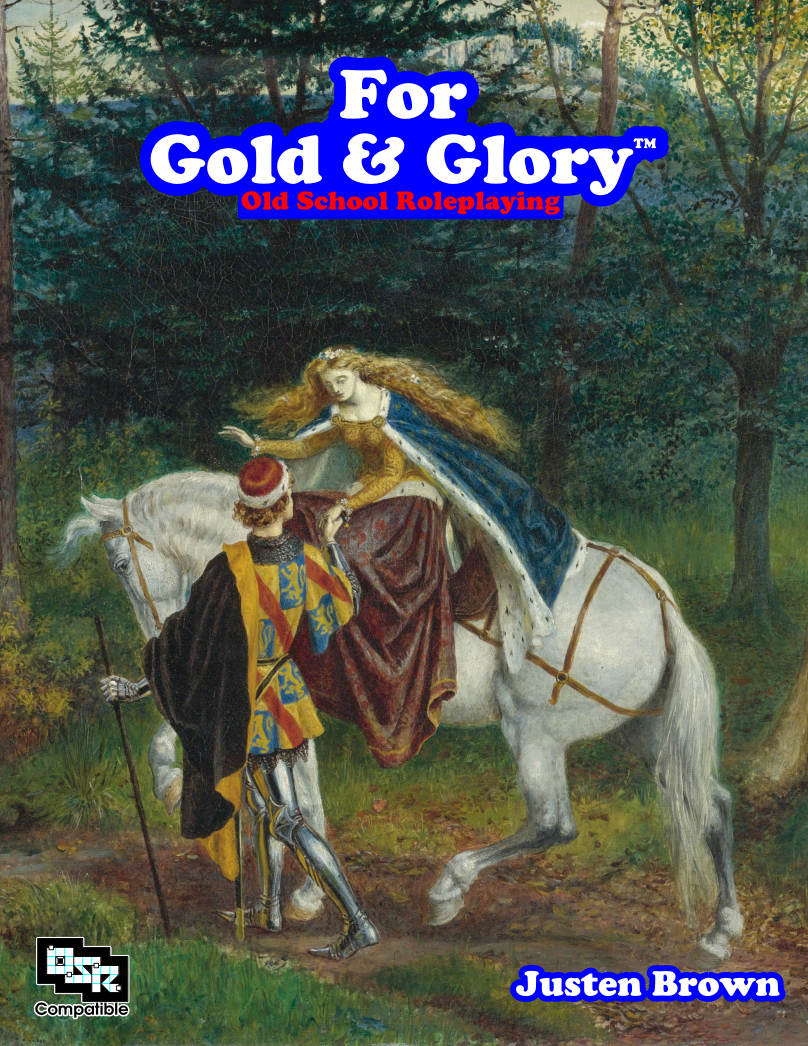
(Walter Crane: La belle Dame Sans Merci, oil on canvas, 1865)
The back cover posted:
For players and game masters alike, For Gold & Glory™ is compatible with the second edition of the “advanced” version of the world’s most popular role-playing game.

Said edition of the most popular RPG in the world is something of a mystery to me. While Forgotten Realms supplements for it were my first experience with tabletop role-playing games, I've never actually played that game. My first D&D experience was 3.5, with a group who (like most) didn't much bother with a close reading of the rules and thought Toughness was a good feat. All I know about AD&D I've learned through osmosis and reading the OSR thread.
So let me crack open this book and read it myself for once. I'll try to do a fairly close reading of the material, but spare you the boring bits.
For Gold & Glory: Table of Content, Forewords and Chapter 0: Introduction
The book begins with a clear and helpfully hyperlinked table of contents. It's a big, nearly 400-page book, but the core rules only take up 94 pages. Most of the book is actually appendices, detailing magic (114 pages), treasure (90 pages) and the bestiary (60 pages). The book concludes with an index (thank you so much), one final appendix for OSR legalese, and a character sheet. A list of tables (also clickable) is also included, and I have a feeling I might actually have to reference that every now and then.
I absolutely will not go through the appendices spell by spell and monster by monster, just so you know.
Before the first (zeroth) chapter, we also get forewords by the author Justen Brown and the editor Moses Wildermuth.
Jason Brown posted:
Cracking open the original 1989 player’s guide, the first illustration you’re drawn to is a full-page oil painting by Larry Elmore. Entitled “Dragon slayers, and proud of it!” the painting depicts five adventurers triumphantly posing before the body of a very young green dragon dangling from a tree as a fisherman would present his prized catch. A small wooden box at their feet held gold coins, a few glittering gems poking out here and there. The adventurers weren’t wearing ridiculously exaggerated armor, bikini-mail with bare midriffs and massive cleavage, or wielding fifty-foot long paper-thin swords. Our heroes were a lightly armored elf archer, a cleric with a hammer and a holy symbol etched on his belt buckle, a massive bearded warrior with rusty chain mail, a smaller raven haired female warrior, and a mysterious looking magic user cloaked in red.
To me, this picture is how I imagine the quintessential adventurers. These allies had braved some distant lair, defeated a mighty monster (as even newborn dragons are not to be trifled with), collected a modest treasure, and escaped with treasure (and a few scars) that tell entire stories. These heroes were the invisible men and women I created in my fantasy video games. I knew that I held in my hand a gateway into majestic worlds yet to be told and I quickly met many people whose vision we all shared. These dragon slayers have made a hobbyist out of me and I’m proud of it.
 I like Elmore's art too. Here's the piece Brown's referring to:
I like Elmore's art too. Here's the piece Brown's referring to: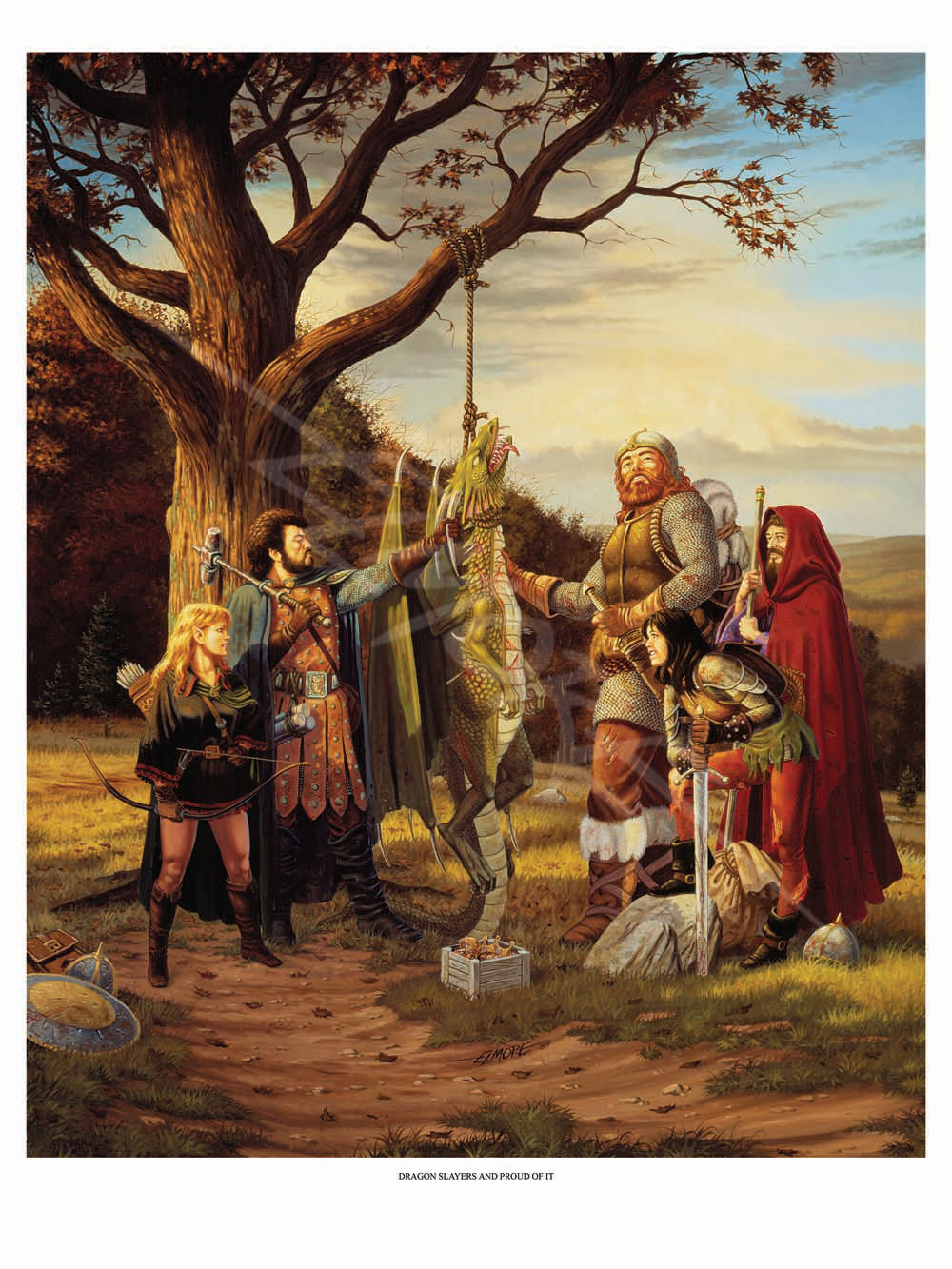
Moses Wildermuth posted:
Even though I didn’t know it at the time, my first gaming experiences were in hybrid games. Thirty years later, I can now see how my first GM had intricately woven rules from the (then) new, “Advanced” version of the game with his favorite house rules pulled from the “Basic” games that came before it and the now infamous RPG magazines of the day: the Dragon, Dungeon, Polyhedron, etc.
For Gold & Glory™ pays homage to this hybrid style of gaming. My primary concern when I took over as editor of FG&G™ was to lay nothing less than a solid, old school foundation similar in style to the second “Advanced” version of the game. My next concern then became to fix any obvious errors and fill in any obviously missing rules.
After all this, we finally get to the oddly-numbered introductory chapter!
...It's exactly what you'd think it is. There's a very short history of
Notably, the Introduction includes the core mechanic for the game: If a situation is not covered by some other rule, you should roll a d20 and add some modifiers. Higher is better. How high is enough? Don't worry about it! Higher is better.
Like always, there's also an example of play, and for what must be the first time in my life, I've read it. A four-person party has just finished murdering some frog-men, and enter a ruined moathouse. The ranger (apparently named Ranger) tries to follow some tracks but unknowingly spooks the brigands keeping watch. The thief (named Thief) wanders off, spots some gold coins and gets ambushed by a giant spider, at which point the brigands lurking in the moathouse decide to make an entrance. It looks grim for our heroes. The GM does not say "roll initiative".
Judging by the example, the game apparently has "skill checks" to read tracks, spells that don't require dice rolls and d6 rolls to avoid surprise. Surprise checks are actually d10.
quote:
Wizard can cast sleep which may be the key to winning the battle.
After the example of play, we get a short glossary of terms:
quote:
Ability Check: A roll of 1d20, plus modifiers, against a relevant ability score. If the result is equal to or less than your character’s ability score the action succeeds. As a general rule, any action not covered by the rules should be handled with an ability check.
 Turns out higher's not better.
Turns out higher's not better. Other quick notes: AC goes from 10 to -10 instead of being unbounded like in later editions. Initiative is a flat d10 roll between parties, not individual Dexterity checks. A turn is ten rounds instead of the other way around, and I can already tell that's going to trip me up hardcore later. Unlike ability checks, both attack rolls and saving throws need to be equal or greater than their target numbers, just like they do nowadays, because it's 1989 and consistency hasn't been invented yet. Finally, unlike in second edition, the great big bugbear of the game is now called THACO: "To Hit A Combat Opponent". I have no idea why, THAC0 did nothing wrong.
The chapter concludes by outlining how a character is created. Roll stats, pick race and class, choose alignment, choose skills, buy equipment. While old grogs might bristle at the separation between race and class, this is familiar stuff for us younger folk. The book says to read chapters 1–6 before making a character so I guess we'll have to wait a couple of updates before digging out the dice.
Usually I skip the introductory chapter altogether, but it turns out this one had a bunch of fairly important stuff in it. I knew making an F&F was a good idea!
As a final note, in the best "free OSR rules" tradition, all the art in the book is public domain. Lots of 19th century chivalric romance, Renaissance portraits and romantic monsters. They're all of good quality and really well chosen for a cohesive look. I'm a huge sucker for that pre-Raphaelite look, so I'm actually enjoying the art a lot.
Coming up next: Chapter 1: Ability Scores!
Chapter 1: Ability Scores
Original SA post
For Gold & Glory: Chapter 1: Ability Scores
It's time for the Big Six! Pick up some dice, roll some stats and shed a tear for the way Baldur's Gate used to let you reroll forever.
For Gold & Glory includes four methods of rolling ability scores:
- Traditional: Roll 3d6 in order and feel bad about it because there's no option to reroll
- Contemporary: Roll 4d6, drop lowest, order as desired
- New Age: Roll 4d4+2, assign as you want but it doesn't matter because they're all 12
- Points System: You get 60 + 4d4 to divide between abilities (no less than 3 and no more than 18), with every 10% of exceptional strength costing 1 point.
What's "exceptional strength"?

Strength
quote:
Strength (Str) represents raw muscle mass and is the most important ability score for warriors. A warrior with strength of 18 can roll a d% for exceptional strength. An 18/61 is stronger than an 18/35.

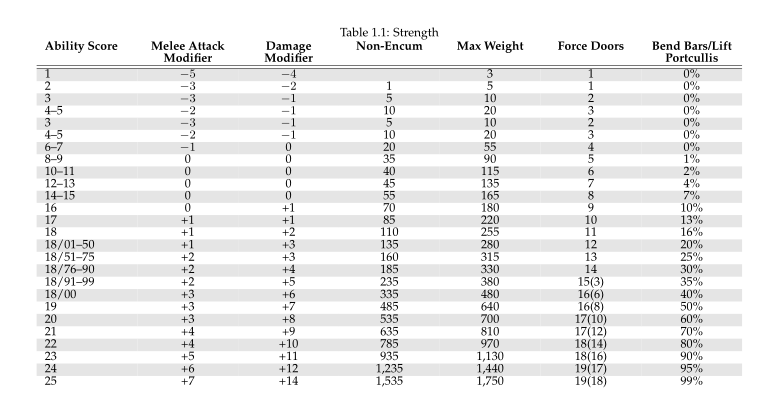
Strength affects the things you'd expect, coming from a later edition: Melee attack rolls, damage, encumbrance and maximum carried weight. Note how you don't get any damage bonuses until 16, and non-warriors flat out can't get more than +1 to attack. The disconnect between attack bonuses (+3 at best) and damage bonuses (up to +6) is a bit odd to my modern eye. I'd hazard a guess this is because the range of possible ACs is so narrow that even a +1 is a meaningful bonus to hit, but hit points just keep growing?
In addition to the expected things, strength also affects attack rolls with the bow. The book directs us to Weapons and Armor: Bows for more information, but I'll do that later.
Strength also lets you open very heavy and stuck doors, as well as bend bars/lift portcullises. Forcing open doors is a d20 roll under the indicated number while bending bars uses a percentile die. You can also try to force open a locked door, but for that you need to use the target number in parentheses. (Don't even bother unless you rolled really well on exceptional strength.) You can reroll a failed attempt when you're bashing open a door, but every try takes an arbitrary amount of time and makes a lot of noise as you work on it. You can't reroll a failed bend bars roll. Either you deadlift the portcullis or you don't, working longer at it won't help.
Exceptional strength works weird with strength-affecting modifiers. Instead of going up to 19 or down to 17, you move from one category of exceptional strength to the next. This seems to mean that non-warriors (or warriors who didn't opt to roll for exceptional strength) get more out of Gauntlets of Ogre Strength or whatever, since those can boost them straight into 19 instead of getting stuck in the percentages.
Dexterity
quote:
Dexterity (Dex) represents reflexes and hand eye coordination. It is the most important ability score for rogues.
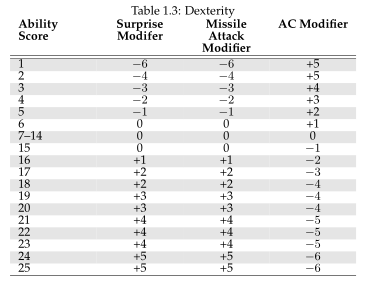
Dexterity only does a couple of things, but they're all quite handy. The surprise modifier affects the d10 roll to avoid surprise, but it's also used to adjust the saving throw versus breath weapons. Similarly, the missile attack modifier affects the penalties for dual-wielding. And just like in later editions, the AC bonus doesn't apply if you can't actually move.
Constitution
quote:
Constitution (Con) represents a character’s physical endurance and is important to all classes. A character’s base constitution is also the maximum number of times they can be resurrected.
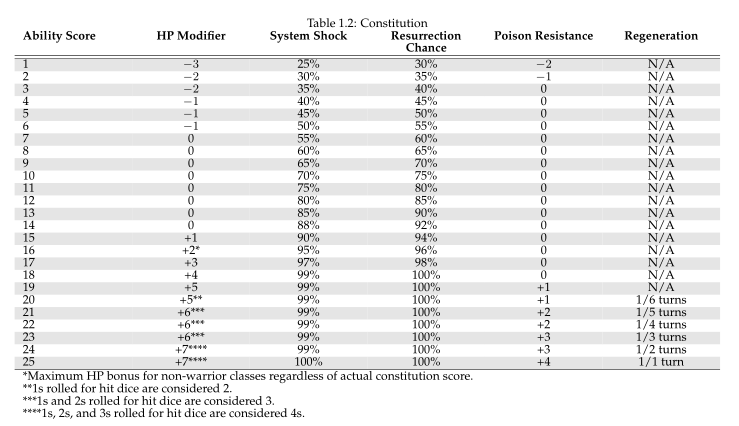
HP modifier is pretty self-explanatory. It's added to hit dice rolled and can not bring the result below 1. The modifier is also applied retroactively, so if your con goes from 15 to 16, you gain one extra hit point for every hit die you have. Note that non-warriors can't have a HP modifier greater than +2.
System shock is the chance to die from magical changes to their body, such as polymorphing or petrification. It's not rolled until the character returns to their original form. Similarly, weak characters might not actually survive resurrection. If you fail the resurrection roll, you go from "mostly dead" to "all dead" and can no longer be brought back. I don't know why these rules exist, but I guess having even unreliable ways out of being effectively dead is better than nothing.
Poison resistance is a modifier to saving throws against poison, but halflings and dwarves don't get it for some reason.
Lastly, constitution 20 and above gives characters supernatural regeneration.
 They heal 1 HP in the indicated time (1 turn is 10 minutes), unless the damage was by acid or fire.
They heal 1 HP in the indicated time (1 turn is 10 minutes), unless the damage was by acid or fire. 
Intelligence
quote:
Intelligence (Int) represents a character’s cognitive reasoning and thought. It is the most important ability score for wizards
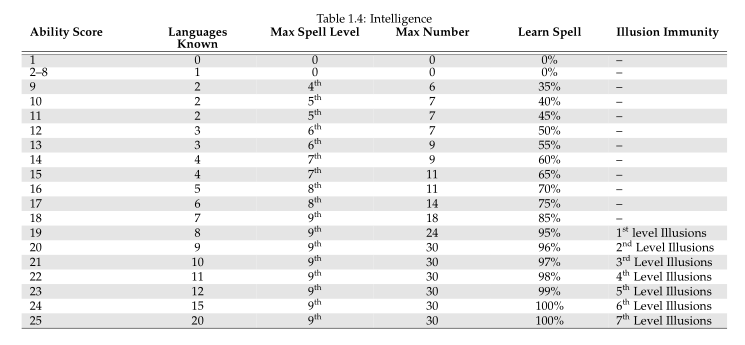
Only wizards give a shit. Max number of spells is per spell level. You can't retry a failed roll to learn a spell until you've gained an entire character level.
Wisdom
quote:
Wisdom (Wis) represents a character’s will power, comprehension, and common sense. It is the most important ability score for priests.
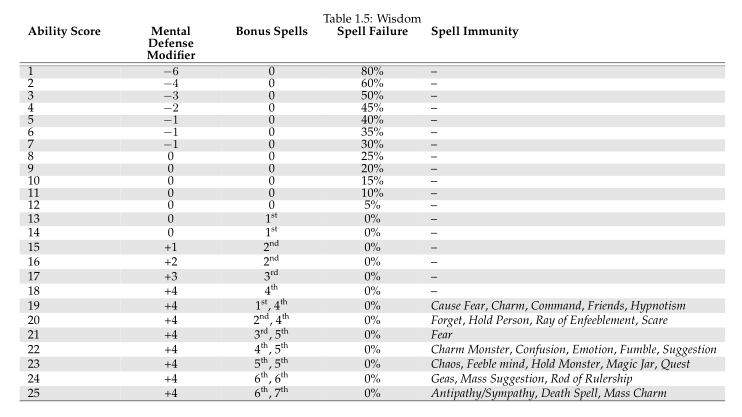
Another spellcaster stat, but this one comes with an upside for everyone: The mental defense modifier applies to all saves against spell effects that affect the mind.
Bonus spells are spells per day, and are cumulative. You risk failing at spellcasting if your wisdom is too low, so rangers and paladins should maybe not dump this stat altogether. Finally, if you're really wise you become immune to a bunch of save-or-die spells.
That last one probably applies for monsters too. I wonder if the book bothers reminding us of that in the bestiary.
Charisma
quote:
Charisma (Cha) represents a character’s personal magnetism and presence. It becomes important whenever any character expect to deal with NPCs. Charisma does not necessarily represent physical appearance, although this may play a role. A horrific monster could have a high charisma, commanding fear through his appearance. A beautiful princess could have a low charisma because she’s shy and introverted.
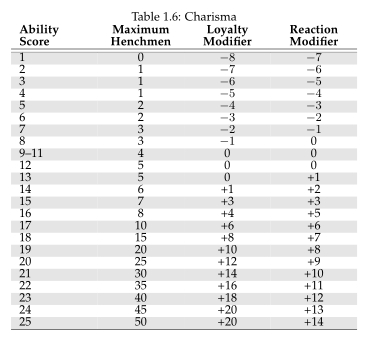
Henchmen are NPCs who work for a character because they're cool people, while hirelings work for pay. Charisma bonuses only affect henchmen. Reaction modifiers affect "random reaction rolls during an encounter", but who knows what that means in practice. Depending on how important that last bit is, this doesn't seem like an important stat for either thing-killing or stuff-taking.
And that's the chapter!
I'm used to third edition's ability modifiers, so this mess of tables is really weird. Most of this stuff doesn't even matter in play because you need to roll pretty awful to suffer penalties and you also need to roll pretty hot to get any bonuses whatsoever. Even then, there's some kind of weird allure here. From third edition onwards the actual score you rolled has been completely meaningless, everything's derived from your modifier and the modifiers are effectively interchangeable through feats. It's all tummyfeels, but having all these weird fiddly derived stats is somehow charming.
I do like how superhuman scores in constitution, intelligence and wisdom actually give you superhuman capabilities that are more than just the regular effects scaling ever upwards. I can't quite decide whether exceptional strength is a cool boon to warrior types, or just dumb fiddling.
Coming up next: Chapter 2: Races!
Chapter 2: Races
Original SA post
For Gold & Glory: Chapter 2: Races
As we all know, in all fantasy worlds there are six races: Grouchy humans, beardless humans, short humans, half-beardless humans, tall humans, and hobbits.
In the last update we learned that you need to have high enough ability scores to qualify as a demi-human (which is D&Dese for "playable non-humans"). Don't worry, all the races come with ability modifiers and you only need to meet the requirements after modifiers. The requirements are also fairly lax, with only dwarves and halflings requiring ability scores over 8.
More strictly, not all races can pick all classes. I have no idea why, but so it goes. Only humans and half-elves can become druids, for instance, and half-elf druids can only advance to level nine out of what I assume to be twenty. I have no idea how this is supposed to work in practice.
Demi-humans can choose to multiclass instead of picking only a single class. The combinations are almost always some mix of fighter, cleric, mage and thief.
Dwarves
Dwarves are gruff and live in the mountains. They get +1 con and -1 dex, are slightly slower than humans and see in the dark. They can become fighters, thieves or clerics, or multiclass as fighter/clerics or fighter/thieves.
They're extra resistant to poison (which explains why they don't get the regular saving throw bonus from constitution) and magic, to the point that they have trouble using activated magic items not made for their class.
Dwarves are huge racists and get +1 to attack orcs and goblins. Ogres, trolls and giants get a whopping -4 to attack dwarves.
Growing up underground has also given dwarves a mysterious ability to notice things like hidden walls or traps built in natural stone, as well as tell how deep underground they are.
Elves
Elves are very pretty, long-lived and standoffish. They get +1 dex and -1 con and see in the dark. They can become fighters, mages, thieves, clerics or rangers, or multiclass in any combination of fighter, mage and thief.
Elves get +1 to attack with bows, short swords and long swords. They're resistant to sleep and charm spells and can notice secret doors.
Elves are also sneaky as long as they're not wearing metal armour or hanging out with the rest of the party, so basically never. It's not even any kind of skill bonus, it's a bonus to surprise checks.
Gnomes
Gnomes are smaller, less grouchy dwarves who live in the boonies. They get +1 to int and -1 to wisdom, are half as fast as humans and see in the dark. They're small, which is probably a massive mechanical pain. They can be fighters, clerics, thieves or illusionists, which are a special kind of mage. They can multiclass any two of these classes, even illusionist.
Gnomes get many of the dwarven abilities remixed: They are magic resistant like dwarves, and suffer even more magical item malfunctions. Like dwarves, they're also racists, getting attack bonuses against kobolds and goblins and giving penalties when attacked by gnolls, trolls, ogres, etc. They also get a version of the dwarves' stone cunning ability that works in natural underground spaces.
Half-elves
Half-elves are less pretty, shorter-lived, more approachable elves. They don't get ability modifiers, but they see in the dark. They can be any class by illusionist or paladin, and they can multiclass in a whole bunch of ways.
They're resistant to sleep and charm spells and can detect secret doors. They're worse at both of these things than elves. That's it.
Halflings
Halflings are hobbits: Sociable, socially conservative. They don't know how to make shoes. They get +1 to dex and -1 to strength, are half as fast as humans and see in the dark. They're as small as gnomes. They can be fighters, clerics, thieves or fighter/thieves.
They're resistant to magic and poison like dwarves (but don't have issues with magical items), stealthy like elves and get +1 to hit with slings. They can also tell directions outdoors.
Humans
Humans can't multiclass or see in the dark.
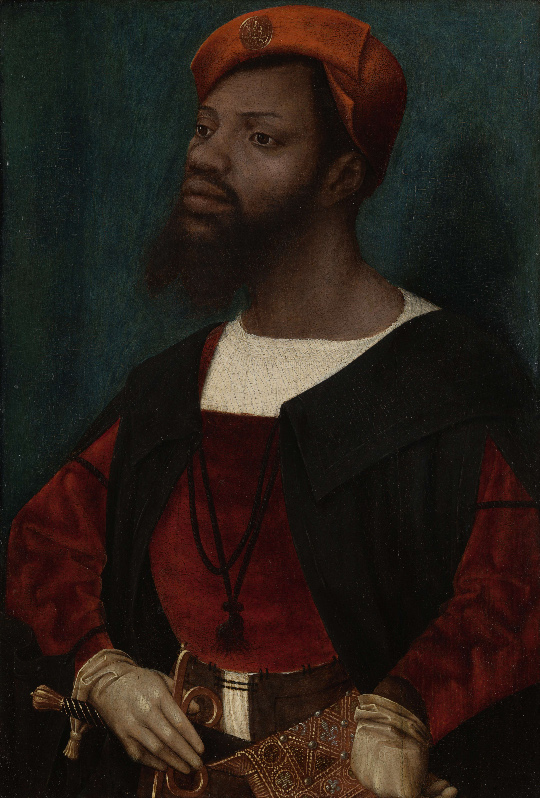
Jan Mostaert: Portrait of an African man (Oil on oak panel, circa 1520–1530)
To cap the chapter off, there's some tables for randomising your character's height, weight and age. There are age penalties.
Restricting classes by race makes no sense because so few of these racial abilities are even any good. What a weird game.
Coming up next: Chapter 3: Classes!
Chapter 3: Classes
Original SA postSpeaking of fighters!

For Gold & Glory: Chapter 3: Classes
We've got our stats and we've chosen a race, now it's time to pick a class. This one's a bit of a long one, since there are quite a few classes with a lot of features in this book.
quote:
All player characters are members of a specific class. Their class embodies their special training before they became an adventurer. There are four class groups; warrior, wizard, priest, and rogue. Each group bestows the same hit dice progression, attack bonus, and saving throw progression.
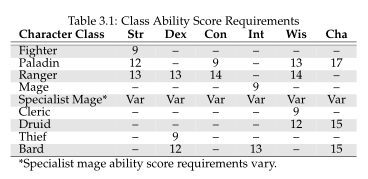
Like races, classes have ability score requirements. Unlike races, these can be really fucking prohibitive. Some classes require 14s and 15s, but the paladin is notorious for requiring 17 charisma to get in. That's a high roll, and the ability doesn't even do much anything.
Luckily, here the book graciously tells you that if you can't qualify for any class, the GM should let you re-roll your stats. On the other hand, you only need a single 9 to qualify for the classic quartet of fighter, thief, cleric or mage, so good luck getting that re-roll.
In addition to ability requirements, all classes come with a "prime requisite": If you meet or exceed the listed ability score, you get 10% more experience points. Different classes require different amounts of XP to advance in level.
With all that out of the way, let's dig into the classes.
Warriors

The warrior classes are fighter, ranger and paladin. They get the best hit die (d10), their THACO advances every level and they eventually get multiple attacks per round. You might remember from the ability score chapter that warriors can also roll for exceptional strength. Their saving throws start out middling, but they get better every other level and eventually overtake the other classes'.
Fighters just fight. All races and alignments can become fighters as long as they have 9 strength. Their prime requisite is strength at 16+. They can wield all weapons and wear any armour, and they get more combat skills than the other classes. Only fighters can specialize in weapons, but more on that in a future update. At 9th level a fighter becomes a Lord and is entitled to construct a stronghold, which will attract a small personal army of about a hundred people.
Paladins have to be Lawful Good humans with exceptional stats. Their prime requisites are Str 16+ as well as Cha 16+ which is a bit weird, since all paladins meet that latter score. Paladins are hella sweet and get a big load of supernatural abilities right out the gate, including a +2 bonus to all saves, a permanent aura of protection and the ability to heal with a touch. Later on they can turn undead like clerics, receive a magical mount (after a suitable adventure) and eventually the ability to cast cleric spells.
In exchange for all this sweet stuff paladins have to follow a code of conduct. They can't carry too many magical items, they have to donate at least tenth of any found treasure to charity (no, your adventuring party is not a charity!) and can't employ jerks for henchmen. Oh and they also can't commit any evil acts or they lose their status as paladins and all associated abilities, becoming a fighter of equal level. Presumably this means they can take combat skills as fighters and can now become Lords, which doesn't sound too bad.
As "hunters of evil", rangers must likewise be some flavour of Good. Unlike paladins, elves and half-elves can also pick this class. The class's prime requisites are Str, Dex and Wis 16+, which is something of a tall order. rangers can track creatures with a successful Wisdom check and they can befriend animals instantly. They can wear any armour, but if they opt for studded leather or something lighter, they can hide in shadows like thieves and fight with two weapons like Drizzt. (I don't know what fighting like Drizzt means in practice. We'll find out later, I hope.) At 2nd level rangers become massive racists, get bonuses to hit their favoured enemies, and start getting reaction penalties from them because the ranger wears their hate on their sleeve. They eventually learn to cast druid spells and attract about a dozen random followers. The followers might include intelligent animals, but rangers never get a dedicated "animal companion" as a separate class feature.
Being goody two-shoes, rangers have their own code of conduct as well. They're loners and thus can't have henchmen or hirelings until 8th level. They can't own more treasure than they can carry, and anything they can't convert to portable currency they must donate to charity. Like paladins, they revert to fighters if they ever knowingly commit an evil act.
Wizard

Wizards include mages and… Specialist mages, who are just like mages but focus on specific schools of magic. Their hit die is the piddly d4 and their THACO only advances every three levels, but their saving throw progression is alright, if very slow. Wizards get access to a new spell level every other character level, and whenever they do, they also learn a new spell of that level for free.
Humans, elves and half-elves can become generic mages if they have at least 9 intelligence. The prime requisite for all wizards is Int 16+, which should be common enough. Wizards can't wear suits of armour (only helmets and gauntlets, for whatever reason), and can only wield daggers, staves, darts, knives (how are they different from daggers?) and slings.
Specialist mages can't use magic from one or more schools of magic in exchange to an easier time with their chosen school. They get an additional spell slot usable only for their school, and every time they learn a free spell from gaining access to a new spell level, they also learn a free spell from their chosen school. However, the ability score requirement to be a specialist are somewhat harsh, since all school require a high score in some secondary ability. For example, conjurers need 15 constitution while necromancers need 16 wisdom.
Priest

Priests are billed as holy men, miracleworkers and spellcasters, but a look at their stats reveals that they're not too shabby in combat either. With a d8 hit die and a THACO that advances two points every three turns, they're not entirely awful in combat, unlike the wizards and the rogues. Priests get middling saving throws, with the exception of being somehow super difficult to poison. They unlock a new spell level every other turn, like wizards, but don't have to learn spells one by one. Priests must be devoted to a belief, but that doesn't necessarily mean believing in some specific god. If the priest loses their faith, they can no longer cast spells.
All creatures of all alignments can become clerics as long as they have 9 wisdom. The cleric's prime requisite is Wis 16+. Clerics can wear any armour, but they can only be trusted with weapons that have no edge or point.
 They can turn undead to make them flee or collapse outright, but more on that in the combat section. At 8th level a cleric who has built a place of worship attracts 20d10 fanatical followers. At 9th level a cleric can build a religious stronghold that functions as a tax haven.
They can turn undead to make them flee or collapse outright, but more on that in the combat section. At 8th level a cleric who has built a place of worship attracts 20d10 fanatical followers. At 9th level a cleric can build a religious stronghold that functions as a tax haven.True Neutral humans and half-elves can become druids if they have 12 wisdom and 15 charisma. The prime requisites are Wis and Cha 16+. Druids can only wear leather armour, carry wooden shields and wield a completely nonsensical assortment of weapons. Druids have access to a somewhat different set of spells than clerics, although both can cast healing spells.
Druids are weird. They get a saving throw bonus against fire and electricity and a weird mish-mash of abilities that let them pass slip through bushes, identify plants, and talk to various woodland creatures. At 7th level they can turn into an animal three times per day. Sounds okay, if kinda niche.
Then, at 11th level they receive the official title of "druid" and begin progressing through the weird druid hierarchy. Druids can only advance beyond 11th level if they can get an in-character promotion, since titles and levels go hand in hand. Finally, at level 16 the Grand Druid breaks free of the hierarchy, quits their job, becomes a "hierophant", stops learning new spells and gains a boatload of weird transcendent abilities like not aging and being able to plane shift at will.
I don't get it.

Rogue

Thieves and bards make up the rogue category of classes. They're fairly fragile characters with only a d6 for a hit die and a THACO that advances every other level. They don't even have very good saves. On the upside, they require the least XP to advance in level, which means that most of the time they'll be a hit die or two ahead of the rest of the party.
Rogues also gain access to the special thieving skills, which I don't quite understand, because the book outright says that anyone can do the same with ability checks. Thieving skill scores start so low that your odds of doing the same thing better by rolling an ability check are pretty darn good. The upside to thieving skills is that a successful result holds until something happens to hinder it, so climbing high walls or sneaking through long stretches of darkness might be easier done with thieving skills. Rolling ability checks every couple of yards dumpsters your chances of making it through.
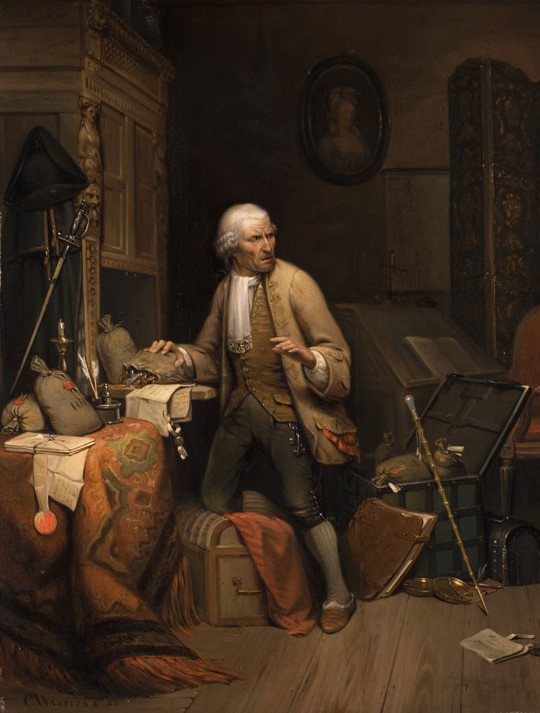
Constant Wauters: Der beim Diebstahl ertappte Hausdiener, detail. 1845.
Any races of any alignment except Awful Goo can become thieves, as long as they have 9 dexterity. Thieves' prime requisite is Dex 16+, in case you want to get all the levels. They can wear leather armour and elven chain, and can wield a mish-mash of edgy weapons. They get a bunch of points to pour into thieving skills, the ability to backstab surprised opponents for massive damage and they get to build a thieves' den at level 10.
Humans and half-elves of partly-neutral alignment (NG, LN, CN, NE) can become bards if they have Dex 12, Int 13 and Cha 15. Their prime requisites are Dex and Cha 16+. They can wear armour up to chain mail and wield all weapons. In addition to thieving ("bardic") skills and knowing stuff, bards can cast a handful of wizard spells and can create almost magical effects with their performances. They can influence non-hostile NPCs' reactions, negate magic that relies on sound or vocal effects, or inspire courage in allies. Like many other classes, bards gain followers at 9th level if they've built a stronghold.
Gee, Black Leaf, how come the GM lets you have two classes?
I've already mentioned the two ways of broadening out your character's competence: Multi-classing and dual-classing. Multi-classing is an option for demi-humans and is a choice made at character creation. Dual-classing is reserved for humans, and it can only be done after play starts.
Multi-classing is straightforward enough: You just pick multiple classes and get all the best sides of each! (Terms and conditions may apply.) If your character is, say, a fighter/cleric, you get a warrior's THACO, a priest's save vs. poison, and all the features of both classes. On the downside, they can't specialize in a weapon like a single-class fighter, and they have to follow the cleric's weapon restrictions. Leveling up is a bit tricky, since you divide all gained experience evenly between your classes. Whenever you level up, you gain hit points according to that class's hit die, but divide your HP bonus from Constitution with the number of your classes, rounding up.
Dual-classing is trickier. At 2nd level or above a human character can opt to permanently stop advancing in their old class and pick another, provided they have a 17 or higher in the prime requisites (yes all of them) of the new class. The character effectively becomes a 1st-level member of their new class, with only the HP and hit dice carrying over. Until the new class's levels exceed the old one's, the character doesn't gain any HP for leveling up. The character can use their old abilities, THACO or saving throws in a pinch, but until the new class overtakes the old, using those means only receiving half the experience points for the encounter. You're supposed to learn adventuring from scratch, not lean on any previously mastered skills.
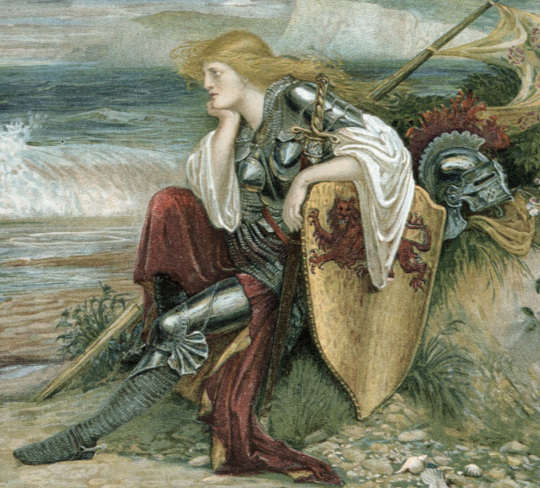
"I miss casting spells."
Walter Crane: Britomart, detail. 1900.
Honestly, this game's growing on me. I do love me a strict class-based system, after all. The four classic classes (fighter, mage, thief and cleric) don't have too many fussy abilities to keep in mind, so even if you welp a character by diving headlong into the green devil mouth, you can probably roll up a new one while the GM takes a potty break. The way some of the more special classes are a pain to qualify for makes me suspect that in some sense, people were expected to be rolling up new characters instead of trying to finish an epic yarn with their starters. Tracking XP is a bit weird, but staggered advancement seems neat enough that I'd like to give it a try and see how tedious it actually is.
Coming up next: Chapter 4: Alignment!
Chapter 4: Alignment
Original SA post
For Gold & Glory: Chapter 4: Alignment
Nice Paladin you've got there. Would be a shame if they... had to do something bad.

I'm just going to rush through this chapter because I don't think doing a close reading of elfgame morality is terribly productive when the game is about killing things and taking their stuff.
quote:
Law and chaos are always in respect to society, authority, or the majority. Following a rigid personal code doesn’t make a character lawful. Chaotic creatures can be honest and mindful of authority. A barbarian raider who refrains from harming women or children is likely chaotic. An assassin who follows the creed of his local guild is likely lawful.
quote:
Good and evil are defined by society. What one society deems to be good another may believe is evil. As a result, few mortal creatures are truly evil. Regardless, good is always constructive while evil is always destructive. Raiding villages for supplies and slaves might be a common practice in one civilization (albeit not a good one) but razing the village to the ground and massacring its residents for personal enjoyment is evil.
quote:
Chaotic Neutral: The belief that there is no order in the universe and that dwelling on moral extremes, good or evil, inhibit personal freedom. Chaotic neutral characters do whatever they feel like with little thought towards the results but neither are they completely cruel or uncalculating. A chaotic neutral creature may simply be impulsive to a fault, make sudden decisions, or prefer to live their lives by the flip of a coin. Considered to be neutrally aligned.

I don't think FG&G's takes on the trite nine are actually that bad, assuming you're interested in playing dashing adventures out to punch dastardly villains in the mouth. With a sword. I mean. Uh. It's okay not to dwell on the ethics of killing sentient things, I promise!
What I'm trying to say is, for once the book actually makes an understandable and even relatable distinction between law and chaos, which is where the two-axis alignment system so often stumbles. Good and evil are usually clear enough, although people do seem to love to set up fucked-up trolley problems for the Paladin. The book spells out that that mortal races are generally born true neutral and are products of their environment and upbringing, while planar creatures are made out of the raw energystuff of their home planes and thus start out aligned with it.
Curiously the author takes the time to clarify that yes, lawful neutral, true neutral and chaotic neutral alignments are each "considered to be neutral aligned", as if we couldn't tell by the name. The same thing happens all along the good-evil axis.
After the alignment descriptions there is a final paragraph on tracking and changing alignment. It doesn't beat around the bush:
quote:
After character creation, the player is no longer in charge of their alignment.
Reading the previous chapter I thought I understood how XP works, but now I'm not so sure. Guess I'll have to keep reading, no spoilers!
I know a lot of people find this kind of cartoon morality extremely dull, but there it is and I don't mind it. As long as you don't habitually interrogate your characters' beliefs in the most obnoxious Socratic manner, it's a neat enough bit of character. The XP penalty for character development is weirdly draconian. I feel like this and the multi-class stuff from the last update are both attempts to portray the character doing some (possibly very literal) soul-searching, but mechanized in a really hamfisted way.
Coming up: Chapter 5: Combat Skills!
Chapter 5: Combat Skills
Original SA post
For Gold & Glory: Chapter 5: Combat Skills
These used to be called "weapon proficiencies" but I'm glad for the change because I always had to look up how to spell "proficiency".
quote:
Combat skills determine which weaponry a character is able to wield, and in what specific way (if any) he can wield those weapons most effectively.
Combat skill points are used to purchase skills with specific weapons and fighting styles, and trying to use weapons you don't know carries a penalty to attack rolls. Warriors get away with a reasonable -2 penalty but wizards are slapped with a ridiculous -5. If you don't know a particular weapon but something like it (say, you're a pole axe specialist and need to figure out a hand axe) the penalty is mitigated. You can purchase weapon skills for either a specific weapon for 1 point each, a group of weapons (say, "axes") for 2 points, or just go ham and buy all melee and hurled weapons of a specific damage type for 3 points. Class restrictions on weapons still apply, mind. You don't get free proficiencies like in third edition.
The points can also be used to purchase "weaponry methods" for different ways of fighting. Fighters can learn any number of them, priests and rogues can learn only one and single-class wizards can only learn ranged or unarmed methods. There are four melee methods: Single-weapon, two-handed, weapon-shield and dual-weapon. Single-weapon method gives you an AC bonus when fighting with nothing in your off-hand. Two-handed method boosts the combat speed of the two-handed weapon. Weapon-shield (or, as SCA people call it, "sword and board") gives an AC bonus, but also allows the user to punch enemies with their shield. Lastly, someone skilled in dual-wielding can wield any combination of single-handed weapons and removes the THACO penalties for using two weapons at once. For one more point you can also buy Ambidexterity, which removes the remaining -2 penalty for wielding a weapon in your non-dominant hand. Ranged methods let you pick one weapon with which you can move while shooting, fight from horseback and, if you don't move while shooting, boost your called shots and give you an AC bonus.
The class chapter hyped the single-class fighter's ability to specialize in a weapon they're already skilled with, and it's not too shabby an ability. It costs one point to specialize in a melee weapon and two to specialize in a bow or crossbow. In return, the fighter gets extra attacks hell yeah!
 In addition, melee weapons get +1 to hit and +2 to damage wheras ranged weapons get +2 to hit at point-blank range (6–30 feet for bows, 6–60 for crossbows) and the ability to shoot from ambush before initiative is rolled.
In addition, melee weapons get +1 to hit and +2 to damage wheras ranged weapons get +2 to hit at point-blank range (6–30 feet for bows, 6–60 for crossbows) and the ability to shoot from ambush before initiative is rolled.Honestly, this all seems fine, if a bit boring compared to the Weeaboo Fightan' Magic of editions to come. With only a handful of methods, there aren't any obvious trap options, except maybe the the two-handed one since it only works when initiative rolls are tied. Sure, single-weapon method is strictly worse than weapon-shield, but not all classes get shields. And honestly, the fighter specialization looks pretty sweet. I'm sure this went on to spiral into untenable skill bloat, but without any additional supplements it seems like a nice bit of spice to combat.
Coming up: Chapter 6: Non-combat Skills!
Chapter 6: Non-combat Skills
Original SA post
For Gold & Glory: Chapter 6: Non-combat Skills
It's the last chapter we need to read before we can roll our own character!
The chapter is not exactly clearly written, but from what I gather, skills are essentially modifiers to the regular ability checks we're already familiar with. Some can be used untrained (which imposes a -2 penalty on the ability check) whereas others are too niche to be attempted without proper training. Not everything has a skill to cover it, in which case a regular old ability check should be attempted instead. If conditions make the check more or less difficult, a modifier between -4 and +4 should be assigned. When the party acts as a group, only the most proficient character should roll a check. Other characters can lend a hand by making a skill check of their own: A success gives a +2 bonus to the big check. Unlike in later editions, rolls of 1 succeed and rolls of 20 fail regardless of the ability score.
Characters start knowing a free trade or knowledge skill representing their past education, and a number of skill points based on their class. Warriors and rogues start with 3 skill points while wizards and priests start with 4. All characters except rogues gain a new skill point every third level, and rogues get a point every four levels instead. Proficiency in a skill costs one or more points depending on the skill and allows a character to use the skill without the untrained penalty. Additional points can be spent on a skill to upgrade it to "advanced" and "mastery", which both give a +3 bonus to the skill. It's still 1989 and this is strictly a class system, so some skills are only available to certain classes.
There's no skill list of any kind, only six pages of descriptions.
 Here's some examples of what sort of stuff counts as a skill:
Here's some examples of what sort of stuff counts as a skill:quote:
Blind-Fight (Rogue/Warrior, 2 skill points) A character trained in this skill isn’t hindered by poor lighting. They suffer no AC penalty in dark conditions and the attack penalties for dim and no lighting are reduced by half (−1 and −2 respectively). The penalty to attack invisible creatures is reduced to −2 (although the character cannot pinpoint their exact location) and characters move at one-half speed in total darkness vice one-third. These benefits only apply to melee combat. Penalties are not reduced for ranged attacks and the −4 AC penalty still applies to ranged attacks. A character with blind-fight cannot actually see in complete darkness, they can just compensate for poor lighting better than most. A character can only be trained in this skill: further proficiency doesn’t give any extra benefits.
quote:
Read Lips (Rogue, Intelligence, −2, 2 skill points) A trained lip reader can discern a conversation via lip movement and body language. Proficiency allows a character to know one language they can speak. They must be within 30 feet of the speaker and be able to see them speak. A successful skill check allows the character to understand the gist of the conversation with basic details and simple names (about 70% of a conversation). A failed check gives no result.
quote:
Cross-Country Running (Warrior, Constitution, −6, 1 skill point) This skill allows techniques that aid in moving swiftly over open terrain. A trained runner may move at twice their movement rate in a day’s march (8 hours) and continue this movement on successive days with a skill check. At the end of a day spent running, the character must get 8 hours of rest or they’re immediately fatigued the next day and cannot run until they rest.
A character who runs cross-country for more than an hour suffers a −1 penalty to attack rolls until they rest for the night.
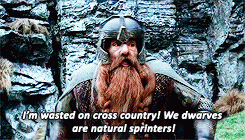
A day's march is actually 10 hours of travel.
quote:
Use Rope (General, Dexterity, +0, 1 skill point, Untrained) A trained character has extensive knowledge of knots and tying techniques. A skill check at a −6 penalty can be used to slip free of knotted bonds. A trained character gains a +2 attack bonus with a lasso and a +2 bonus to climb checks when assisted with a rope. A trained character can bind someone with rope: on a successful check, no human-sized creature can break the binding unless they have strength 20 or greater. A failed check allows a character with 18 strength or greater to break the binds or slip out with a dexterity check at −12 penalty.
Certain Trade skills can be used to make stuff, but making any equipment takes weeks so I'm not going to bother.
There are a bunch of other skills and Knowledge, Perform and Trade aside are all more or less useful. At first I was a bit leery of muddling a perfectly fine ability check framework up with skill bloat and untrained penalties, but there are actually only seven skills that you can attempt untrained and their implementation is interesting enough that I'll give them a pass. FG&G's skills tend to allow trained charcters to pull off neat stuff without any rolls, so buying them feels less like a tax and more like a deal.
Incidentally, I much prefer this "Trained/Advanced/Master" framework to skill points. In 3.5 in particular, counting skill points was the biggest chore in making and leveling characters, and the few times we actually had to roll a skill check never really justified the effort.
Coming up next: Enough talk, let's roll a character!
Intermission
Original SA post
For Gold & Glory: Intermission
We did it, we finished chapters 1–6! We can roll a character now!
Siivola posted:
The chapter concludes by outlining how a character is created. Roll stats, pick race and class, choose alignment, choose skills, buy equipment.
The dice came up 13, 14, 15, 16, 16 and 12, which is a remarkably good array! I could pick any race with these scores, and while the paladin is just slightly outside our reach, I could do a bard, a specialist mage or... A ranger!
It's not every day you can roll a ranger so let's go with that! For race I'm going to choose the elf, because they get a +1 to hit with swords and bows, and because the Elf Ranger is such a classic look.
The ability requirements of the class are strict enough that I don't have that much choice on how to assign the scores. I can't quite nail all three prime requisites of the class, so I think I'm just going to try to maximize my chances of survival instead. I'm going with an array of Str 15 Dex 17 Con 15 Int 12 Wis 14 Cha 13, after racial modifiers.
For alignment I'm going to go with full-on Lawful Good, since most ranger types seem to be complete Chaotic anarchists and I feel like playing against type for once.
As a warrior, the character (let's call her Goonwien) gets 4 combat skill points, 3 non-combat skill points as well as a free knowledge or trade, and her okay intelligence gives us 3 extra languages. Characters don't start proficient in any weapons, so I'm going to pay 2 points for proficiency in all swords, and (after checking the price of the longbow
 ) 2 more for all bows. Combat methods can wait, I guess. For skills I'm picking climbing, cross-country running, survival and swimming, and the free trade skill's going to be carpentry. Elves only get to choose from so many languages so I'm picking gnome, halfling and hobgoblin.
) 2 more for all bows. Combat methods can wait, I guess. For skills I'm picking climbing, cross-country running, survival and swimming, and the free trade skill's going to be carpentry. Elves only get to choose from so many languages so I'm picking gnome, halfling and hobgoblin.Equipment doesn't come up until the next chapter, but I'm going to give you guys a sneak peek: Warriors start out with 5d4 * 10 gp. I roll somewhat low and only manage 100 gp. Not a whole lot of money in frontier carpentry, I guess. Still, that's more than enough for an full arsenal of a long sword, a short sword, a shortbow, a suit of studded leather armor and a buckler. (Bucklers leave both of your hands free, remember?)
Finally, I'm going roll random height, weight and age for the heck of it: She's 4'7", weighs 82 lbs. and is 121 years old. That's a long-ass time spent on carpentry, at least by human standards.
Wait, I forgot something. Something to do with… Health?
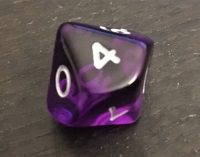
Aw. Well, at least she gets a +1 bonus from her constitution.
quote:
Goonwien
Elf Female, 1st-level Ranger
THACO 20, 19 (swords), 17 (bow); #AT 2; Dmg 1d8 (long sword), 1d6 (short sword), 1d6 (shortbow); AC 3 (studded leather, buckler, Dex); hp 5; MV 12; SA Attacks with two weapons, enchantment resistant, stealthy, infravision 60 ft., keen senses, MS 20%, HS 20%, tracking, animal empathy; SZ M (4'7" tall); AL LG.
S 15, D 17, C 15, I 12, W 14, Ch 13.
And there we have her! Goonwien, the two-sword-fighting, bow-shooting, house-building endurance athlete is finished. As a ranger she gets no penalties for fighting with two swords as long as she's not wearing heavier armour, and high dexterity means she's an okay shot with a bow. It's not listed above, but she also gets a handy -2 bonus to saves vs. breath from her dexterity, and a +1 to reaction rolls from charisma. She's pretty squishy with only 5 hp (
 ) but I'd say AC 3 is pretty boss for a first-level character who can't even afford metal armor.
) but I'd say AC 3 is pretty boss for a first-level character who can't even afford metal armor. To be honest, this took me quite a bit longer than I was expecting because I haven't rolled a D&D character in ages and ended up doing a lot of page-flipping back and forth, comparing fighting styles and skills and checking ability scores and, and, and.
 I'm nonetheless absolutely convinced this was far less painful than making a first-level character in 3.5!
I'm nonetheless absolutely convinced this was far less painful than making a first-level character in 3.5! 
Coming up next: Chapter 7: Equipment!
Chapter 7: Equipment
Original SA post
For Gold & Glory: Chapter 7: Equipment
Since D&D is a game about killing things and taking their stuff, some rules for said stuff are in order. Welcome to the shoddiest-edited chapter yet!
Money
The most important stuff is, of course, money. Characters might find copper pieces, silver pieces, gold pieces, and even electrum and platinum pieces in their adventures. Of these, normal people use on copper and silver, but both banks and adventurers tend to prefer the gold standard. The three common coins follow a straightforward system where 100 cp = 10 sp = 1 gp. Electrum and platinum are ancient stuff, found usually only in old ruins and hobbyist collections and as such have weird antiquated exchange values. As electrum is an alloy of gold and silver, it's worth five silver pieces. (The conversion table fucks up and says it's worth only a fifth of a gold piece instead of half.) A platinum piece is 10 electrum pieces, so 5 gold pieces. Clear as mud.
Conversion rates have a practical application, since somehow 50 coins of any kind always weigh 1 pound. If the characters want to travel with their money, they might want to exchange their coinage for a more portable currency. The chapter doesn't include prices for gemstones, so platinum bars are probably the most portable you can get, short of investing in livestock.
Player characters start with a random amount of money based on their class. Since fighters and priests rely on the heaviest armour, they get the most (on average, at least).
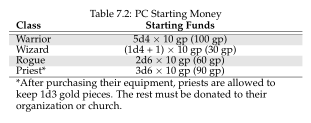
The numbers in parentheses claim to be the average results for the die rolls, but whoever calculated them lowballs the results a fair bit.
Everyday stuff
This section includes stuff like backpacks, baskets and… Huh. Turns out someone left out the 10' pole. They even mentioned it in the example of play back in Chapter 0. This is a bit of a let-down.
It's a boring section but I guess if you really need to know the price of a pair of sandals (5 cp) or the weight of a water clock (200 lbs.) they're here for you. There's two separate tables of provisions like pickled fish by the barrel, but I can't tell why they've been separated. There's also living costs for different lifestyles. A "poor" lifestyle only costs a flat 5 gp a month but anything higher actually factors in your level. For example, a 9th level Fighter who maintains a "wealthy" lifestyle befitting of a Lord pays 1800 gold pieces per month in... Rent and household staff wages, I guess?
Speaking of wages, sending a message by courier costs 1 sp and you can get your grody dungeon-crawling clothes washed for 1 cp.
Tales of high adventure, indeed.
Animals and transport
Animals are really expensive and require daily food and drink. There's multiple varieties of both horses and elephants, and five different quality levels for any horses you might purchase. Beware of swindlers!
Table 7.11 includes prices for a whole bunch of animals, but only some get described. The descriptions for various animals largely address how often they need to be fed and watered, and whether they will need to be kept tethered or not. Oddly, there's a description for yaks but they're not on the table.

There's a second table for tack, harness and stabling. Animal-sized armour is more expensive than the actual animal! There's also a table for the prices of various means of transport, like carts (horse sold separately), canoe and caravel. A caravel costs 10,000 gp, in case you're wondering.
Many descriptions here modify or otherwise reference the animals' speed and carrying capacity, but neither is actually included in the creature table or the descriptions. Instead, the encumbrance values for domestic animals are hidden way at the end of the chapter, and movement rates for animals can be found in Appendix C: Bestiary, under "Animal". It's a bit of a bother.
Weapons
Before we take their stuff, we must first kill the things, and trying to kill things bare-handed is a huge chore. Thankfully D&D is famous for giving us a wide variety of weapons to get the deed done.
First of all, there are about fifty or so different melee weapons, all with a bunch of different stats:

Like any equipment, weapons have a price and a weight in pounds. All items also have a size but for some reason it's only listed for weapons. Damage type is one or more of slashing, piercing and bludgeoning. Combat speed determines which strikes first when initiative is tied, lower being better. (Magical enchantments make weapons faster.) The first damage column is for damage dealt against man-sized (M stands for "Medium") or smaller opponents, the second for larger creatures.
Weapon size affects encumbrance (more on that in a bit) as well as how many hands it takes to wield the weapon: Humans can wield medium and smaller weapons one-handed, but need two hands for large weapons. Small creatures like gnomes and halflings need two hands to wield medium weapons and presumably can't use large weapons at all. All of the weapons in the book are made for human-sized creatures, but it's implied that equivalent equipment for smaller and larger creatures exist. There's just no rules for those.
And since it wouldn't be proper D&D without them, here's some pole arms:
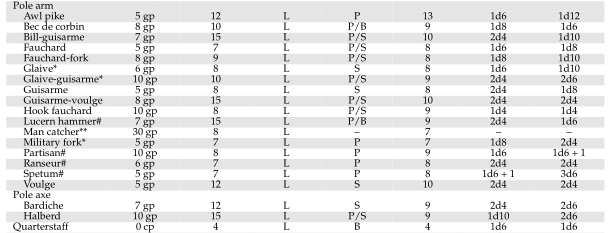
Note how all over the place the damage values are. Some weapons are extra good against large enemies, others way worse, some don't care. I can't find any rhyme or reason for the differences.
Side note: It's been said before but I guess I'll repeat it: D&D weapons are, as a rule, ridiculously heavy. If you're curious about swords you should put the rulebook down and pick up something by Ewart Oakeshott instead.
In case you don't want to risk an acute case of stabbing, the game also includes some ranged weapons. They have largely the same stats as their melee counterparts, and in fact you can "hurl" some melee weapons at the enemy without any penalty I can find. Additionally, ranged weapons have stats for ranges and rates of fire.
Ranges are expressed as now-familiar bands of short/medium/long, with a -2 penalty to attack at medium range and -5 at long. As you might remember from a previous update, fighters who specialize in bows or crossbows gain an additional point-blank range where they get a +2 bonus to hit. The short range on a bow extends up to 150 feet, which should be plenty for any dungeon.
Rate of fire tells us how many attacks a character can make with a ranged weapon in a given number of rounds. For instance, thrown darts have a rate of fire of 3/1 for three attacks per round, while a heavy crossbow has a glacial ROF of 1/2, meaning an attack every other round. I'm pretty sure this means that missile weapons let any character make multiple attacks each round as long as they have the darts to spare.
If this makes bows sound like a sweet option, yeah they sound hella sweet! However, you can't be a complete wimp if you want to use one, since in addition to the regular Dex modifier to ranged attacks, bows also add their Str modifiers to both attack and damage. Characters with exceptional strength need to find a custom bow to take full advantage of their huge guns. Crossbows are a slower, more reliable option for characters who used Strength as their dump stat.
Armor and shields
Unlike in later editions, armor isn't technically a modifier on your AC – it is your AC. Unarmored AC is always 10 before modifiers, and wearing armor replaces that with the armor-specific value. A padded gambeson gives you AC 8, a suit of chain mail AC 5 and a custom full plate harness a sweet AC 1. If through some magic your unarmored AC is already lower than the listed number of your armor, the armor doesn't do anything. Halfling-sized armor costs as much as human-sized, but is half as heavy in pounds.
Helmets are sold separately. Not wearing a helmet gives you a +1 penalty to AC, regardless of what kind of helmet it is.
If you want to boost your defenses further, you get a variety of shields to choose from. They all give you a -1 AC bonus against frontal attacks, but for most of them there's a caveat: A tiny buckler only lets you use the bonus against one attack, a small shield two and a medium shield three. The tower shield is an exception as it protects you from any number of attacks, and gives you a -2 bonus against ranged attacks to boot. On the upside, using a buckler leaves both of your hands free to wield weapons. In case you're wondering, the AC bonus from the weapon-shield combat method has no restrictions on facing or number of attacks.
Donning armor takes time, so getting ambushed at night is bad news. Plate armor takes 1d6+4 rounds to put on and requires help from a buddy. If you try to do it yourself, the time is tripled. Lighter armor slips on in one or two rounds, and the time is only doubled if you're doing it alone. Getting out of non-plate armor takes a round, while getting out of plate takes up to five. A round is roughly equal to one minute, so this is only slow in combat terms.
Second side note: Yes, the terminology is all made up. A guy by the name of Ian LaSpina's done a really good Youtube series on various bits of armor and I recommend checking him out:
https://www.youtube.com/watch?v=eQDMtFiDaEA
Encumbrance
All of this crap weighs a ton and needs to get transported somehow. FG&G tackles the issue by tracking both encumbrance (item weight) and carrying capacity (item size).
To determine encumbrance, you simply total up the weight of all the crap your character is carrying and cross-reference with your Strength on the encumbrance table.
quote:
There are seven stages of encumbrance in increasing order of discomfort: non-encumbered, lightly encumbered, moderately, heavily, severely, and overwhelmingly encumbered.

quote:
A man-sized biped can carry up to twenty small-sized objects (attached to a belt, cloak liner, or bandoleer), four medium-sized objects (two on each hip and two slung around its back), and two large-sized objects (one in each hand). A man-sized backpack and two large belt pouches can also be worn.
Being even lightly encumbered means taking a penalty to your movement value, and the penalty gets stricter the more you carry. If you're at your maximum carrying capacity and at least moderately encumbered, you start taking additional penalties to your attack roll and AC.
Overall, this chapter leaves me pretty lukewarm. There's a lot of plain old crap in the equipment tables that belongs in some kind of Magical Hanseatic League supplement instead of the core book. I would probably read that supplement! But I don't need to know the price of soap or a gallon of beer to make a character. Same goes for the weapon list, which is huge just for the sake of being huge. The vast majority of damage dice fall between 1d6 and 2d4 so you might as well pick a sack full of clubs for your weapon. Sure, I'll take an arbitrary number of these free hurling weapons, whatever.
I actually like the carrying capacity rules, but I'm not so hot on keeping track of every ounce and pound my character has in their belt pouches. I get that weight is meant to be the balancing factor for a lot of good equipment like plate armor and tower shields, but I can only stomach so much bookkeeping. I think I get why the chapter's the way it is, and making a super-detailed list of provisions for a dungeon expedition sounds sort of fun, but I'd probably find it interesting exactly once and never again ever.
No 10' pole, 0/10.
Coming up next: Chapter 8: Combat!
Chapter 8: Combat
Original SA post
For Gold & Glory: Chapter 8: Combat
Before the book dives into combat, it helpfully tells us that not all encounters need to end in combat, and not all combat needs to be fought to the death. Characters can try to evade the encounter, try to talk it out or simply wait and see what happens. More on that in Chapter 10: Encounters, I bet.
But we're not going to wait! Chaaaarge!

It's clobberin' time!
Time in combat is, as mentioned previously, measured in one-minute rounds. Everyone acts simultaneously in combat and every round of combat follows a set sequence:
- GM decides the actions of the monsters.
- The PCs declare their actions and begin casting spells.
- Initiative is rolled for all opposing parties. It's an opposed d10 roll between groups, lower being faster.
- Actions are resolved and spells finish casting in order of initiative.
It's not mentioned in the book how you're expected to keep track of this. I'd probably use dice or sketch a ten-step initiative track on a piece of paper and use meeples or whatever on that. Or just have encounters happen on flat dry land.
I've got things to stab, places to be
In a round a character can move their full move value, cast spells, make attacks or do stuff like light a torch or drink a potion. Notably, drawing a weapon or getting up from prone do not take any meaningful time.
If a character opts to use the entire round moving, they can move ten times their movement value (or MV) in feet. Unencumbered humans can hustle up to 120 feet a minute. Enemies can't move through each other and changing your facing doesn't take extra movement. If you're engaged in melee with a creature, you can safely withdraw with a full move. You can also opt to flee, moving ten times your MV in yards, but everyone adjacent can make a free full attack on your sorry ass.
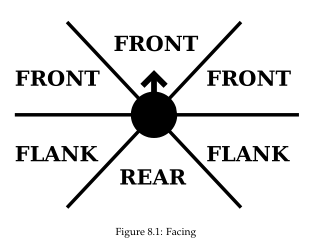
Counting squares is for MMO babies, real gamers use hex maps!
Casting spells modifies the caster's initiative, so they'll usually act after the rest of the party. Spellcasting begins before initiative is rolled and finishes on the caster's turn. The spellcaster can't move while casting a spell and lose their Dex bonus to AC. If the caster takes any damage or fails a save while they're at it, the spell fizzles. No ifs or buts. If the spell requires a touch attack against an enemy, the caster makes an attack roll against AC 10 modified only by dexterity and magical bonuses. Touching a willing target who thoughtfully waits for the touch doesn't require a roll, but if the target is doing anything at all the caster must make an attack against AC 10.
Attacking enemies is pretty straightforward. First you find your THACO (which sadly no longer stands for "to hit AC 0") and subtract the target's AC from it. Then you roll a d20 and add any to-hit modifiers from magical weapons, high stats and circumstances. If the roll is equal to or greater than the modified THACO, you hit! Congrats, now roll damage. If the enemy runs out of hit points, they die. (There are no rules for automatic misses or hits on natural ones and twenties.)
Side note: If you're mathematically inclined, the above can be expressed as an inequality where the attack hits when d20 + modifiers ≥ THACO - AC. As long as you remember to change the sign as you move things from one side to the other, fiddle with it to your heart's content. Add the AC to the die roll as another modifier, or subtract your strength bonus from your THACO so you don't have to do the math every single time. Calculate the formula by which THACO is determined and bring BAB back. Go wild!
Even if you use your action to attack, you can move up to half your normal speed. Attacking doesn't end the move, so you can move, attack and move again, but any enemy you're "engaged in melee" with can opt to block your movement. If you manage to maneuver to an enemy's rear (flanking them isn't enough), they lose their dexterity bonus to AC and you get +2 to hit. If you're using a ranged weapon while moving, you halve the weapon's ROF, unless you've bought the relevant missile weapon combat method.
You can also chaaaaarge, which lets you move one and a half times your full movement before attacking. This gives your first attack +2 to hit but you lose your Dex bonust to AC, get a +1 AC penalty on top of that and your target gets -2 to initiative so they just might manage to run away.
If you have multiple attacks, you get to make all of them whenever you attack. Suck it, 3E! Your first attack is done at your regular initiative count and the rest after all other actions have been resolved. If multiple characters have multiple attacks, they get resolved in initiative order as usual. Odd numbers of attacks are divided so that you get the extra attack every other turn: A character with 3/2 attacks attacks once on the first round, twice on the second and then again once on the third. These rules apply in both melee and ranged combat.
Fighting with two weapons adds a full extra attack per round with your off-hand weapon, but you get -2 to attack with your main hand and -4 for your off hand. The penalties can be mitigated with a high dexterity, combat skills or by playing a ranger. The off-hand weapon must be smaller than the main hand one unless you bought the two-weapon combat method.
When you guys said 2E warriors don't fuck around, you weren't kidding.

For special combat maneuvers, the book includes brawling, wrestling and overbearing. If you attempt any of these on an armed opponent, they get an opportunity for a free attack. Brawling and wrestling work identically: You roll a regular attack roll and refer to a table to see what happens. Natural one is not an automatic miss but a natural 20 is still and automatic hit. If you have the appropriate unarmed combat method, you get bonuses to hit and damage and can adjust the maneuver up or down. If you're wearing heavy armor while wrestling, you get a penalty on the attack roll.
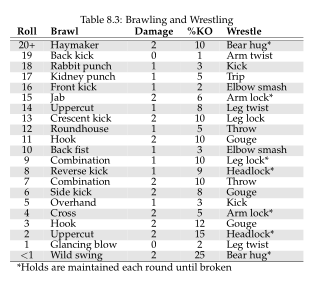
The %KO value is the probability to knock the opponent out, stunning them for 1d10 rounds. Brawling moves deal the indicated damage while wrestling moves all deal a single point. Strength modifiers apply. If a wrestler scores a hold, it deals a "cumulative 1 point of damage per round held" until the hold's broken. So if you score an arm bar, I guess the damage ramps up until you tear off their arm and they die? That's pretty metal.
Overbearing is an attempt to drag an opponent to the ground. It's made by making a regular attack roll against a target, but you get a modifier based on the size difference and +1 for every attacker beyond the first. The weakest attacker makes the actual roll, but size modifiers are determined by the largest attacker. A successful attack roll drags the target down (any attacks against them get +4 to hit but they're free to stand up) and a second successful overbearing attack pins them, presumably making them helpless (any attacks hit automatically). I don't know if that's ever actually useful, but it's pretty cool.
There's a bunch more niche stuff in here like shooting arrows into melee, tossing flasks of holy water or massive rolling boulders, turning undead (and paladins!), mounted combat and so on and so forth, but I'm going to skip past them because oh boy there's so much stuff in this chapter and it's all over the place.
The end is near
Wedged between morale and advanced combat rules there's also the thrilling conclusion to the example of play from the introductory chapter. The GM makes an effort to gank Wizard the wizard, but his shield spell keeps him in the fight long enough for him to cast sleep on the attacking brigands. The only unaffected brigand loses their nerve, turns to run and gets stabbed by Ranger. Thief hides from the spider that tried to ambush him, so logically it also attacks the brightest-coloured, softest target it can see. Wizard survives with 1 hit point. Fighter tries to fight the spider off but rolls a 1 on his attack roll, which "is automatic failure and usually something inconvenient happens". This rule doesn't actually exist anywhere in the book but go off, I guess. After they dispose of the spider, Ranger and Fighter start bickering over what they should do with the brigand leader, the nearly-dead wizard begs for healing and Rogue tries to loot the sleeping brigands. They make enough noise to earn a random encounter roll for their troubles.
People die when they run out of hit points. No negative hit points, no "dying" state, you drop stone dead when your last hit point goes. If a creature ever loses 50 hit points at once, they need to save vs. death or die outright. Only specific spells can raise the dead, and they don't always work. Characters heal 1 hit point per day of rest naturally, and complete bed rest increases the rate to 3 per day. Help from a trained healer can boost this rate. Healing magic exists.
However, like I said in the beginning, not all combat needs to be to the death. And honestly shouldn't, either, because this game doesn't give you a whole lot of HP to fuck around with. To determine if they stick around, most NPCs and monsters have a morale stat that gets checked every now and then to see if they're still willing to stick around and get murdered. Unlike ability checks, the morale check is done by rolling 2d10 and comparing it to a creature's morale rating. Rolling equal or less means the creature succeeds in the check, rolling over means they retreat, surreder or comply. Angry mobs might have a morale score of 9 while a band of trained soldiers rate a 12. Animals don't typically fight to the death so the GM is encouraged to send them packing at the first injury, but unintelligent monsters like undead might stick around to the last bone.
Morale checks shouldn't be made every round since that bogs down the game. Good check points include:
- The first round after being surprised
- When a 25% of their allies have fallen
- If someone gets blown to gory bits by magic
- When there's only half left
- If their leader dies or flees.
Getting stabbed is not the only way characters can get hurt. Hazards like explosions, land slides and death magic are resisted with saving throws determined largely by a character's class and level. Saving throws are done by rolling 1d20 plus any modifiers against the saving throw on your character sheet. Spells and effects usually specify which save to use, but if it's ever unclear just look at the saving throw table for your class and start from the left: A poison effect from a wand would use the save vs. poison instead of the save vs. wands.
In case you need to fuck up an inanimate object, there are rules for damaging those as well. Items have hit points, AC and saving throws much like characters. If a character fails their saving throw against something that could ostensibly destroy an item they're carrying and the item is weak to that particular hazard, they should roll a saving throw against that threat to see if it's destroyed. For instance, if a wizard carrying a magical scroll in their hand gets caught in a fireball, the scroll might just go up in flames alongside the wizard.
In addition to immediate death from being stabbed or incinerated, there are a number of grisly conditions characters might end up afflicted by, from blindness to permanent insanity. They can also get poisoned, cursed with lycantrophy or contract some kind of deadly disease. Poisons take a short amount of time to take effect, after which the hapless character needs to make a save vs. poison. If they fail, they will suffer the poison's full effect, be it temporary paralyzation or outright death. A successful save prevents the worst, but the character might still suffer damage.
Diseases work somewhat similarly: Instead of a saving throw, there's a small percentage chance to contract a disease whenever you come into contact with it. After a short incubation period the character falls ill and their strength and constitution are halved. After the disease's duration runs out, the GM rolls a percentile die to see if the character dies, after which the character starts recovering any lost abilities at a rate of one point per day. Somewhat oddly, the book suggests that every time our heroes enter a dungeon, they risk catching cholera, dysentery and typhoid fever, or potentially all three at once.

Conclusion
Holy balls this was a long, meandering update. There's a lot of stuff I like in this chapter, like the initiative system, how buff fighters are and how hard combat spellcasting gets hosed, but for every cool thing there seems to be something lame like the 4% chance to contract dysentery every time you set foot in a dungeon.
I used to like THACO on paper, but now that I've spent a week reading about to-hit modifiers and AC modifiers and skill check modifiers, having some rolls go over and some go under and only some bonuses being negative is getting really confusing. I keep getting thrown for a loop by how a to-hit penalty is a -2 to your attack roll, but a skill check penalty is -2 to your ability score. I legitimately appreciate that the target numbers for all your rolls are right there on your character sheet, but oh man, it's all quite 1989.
Coming up next: Chapter 9: Adventuring and Exploration!
Chapter 9: Adventuring and Exploration
Original SA post
For Gold & Glory: Chapter 9: Adventuring and Exploration
This is the other major rules chapter, detailing all the stuff that happens between encounters.
quote:
The player characters are typically pioneers and explorers struck with an insatiable wanderlust. This section covers the inevitable situation when characters decide to travel into unfamiliar territory.
Time and travel
Like in the combat chapter, we start out by defining the rules for space and time.

Time passes at the GM's whim. Rounds are still a minute long and turns are ten rounds, but it's likely real-world units like hours and days will be more useful. The GM is encouraged to skip ahead if nothing interesting is going on.
Movement is again defined by the character's movement value, or MV. That's 12 for medium-sized creatures like humans, 9 for dwarves and 6 for small creatures like gnomes. There are different types of movement, all tracked by the round:
- Cautious movement lets you keep "a mental map of your surroundings" and watch for dangers. This is used in dungeons and buildings, underground and in combat. You can move ten times your MV in feet per round.
- Plain old walking is what you do when you're out and about, taking a walk through the woods or the city streets. Your pace is a brisk ten times your MV in yards.
- Hustling is just like walking, but in a dungeon. It imposes a -1 penalty to surprise rolls and a +1 bonus to any opponents' surprise rolls. You can't spot traps while hustling.
- If you need to run to escape from pursuers, roll opposed initiative checks between the pursuer and pursuee. If the fleeing party wins, they increase the distance by ten times the difference in rolls and if they lose, the distance decreases similarly. The book says to use feet or yards "depending on terrain and circumstance, as above", but I don't quite see when you would ever try to escape by cautiously walking away. Running carries the same surprise modifiers as hustling, and you can't detect hidden features.
If you're mounted, you instead move your mount's MV in miles, twice that if pushed or triple that if you want to risk literally riding your horse to death.
There are terrain modifiers for crossing more or less difficult terrain, and for once they're reasonably clear. The distance a party travels in a day (say, 24 miles for a group of humans and elves) is their "travel points", and crossing difficult terrain costs a varying amount of points. Flat grassland is 1, for instance, moors 4 and high mountains as much as 8. Once you run out of travel points, you're done for the day. Traveling by trails and tracks halves the cost, and proper roads reduce it to half a point flat as long as the terrain is not outright mountainous. There are also obstacles that add to the cost of travel, so fording a river adds 1 point and pissing rain would double the cost.
If characters can't find a route to their destination but are still able to backtrack, they're said to be lost. If they can't even find their way to where they started, they're hopelessly lost. Every day characters move overland without following a trail, road or river, and whenever a river they're following empties into an estuary or a swamp, a percentile check should be made to see if the party gets lost. The odds depend on the surrounding terrain and various factors like visible landmarks and such. If they do, the GM should keep it to herself and randomly roll to see which direction the party wanders off to.
Side note: The rules are entirely fine but don't give any guidance on how to use them in practice. "The town's two days south as the crow flies, let's just walk that way" is a really fucking bad idea and you shouldn't do it. "Let's walk to the ruined shrine south from here, stop for dinner and head on to Goblin Rock for the night" is way better because you can tell you're lost if you can't find the place you're looking for. Likewise, the GM shouldn't just teleport the party a day's travel in a random direction, but instead check their map to see if they run across any landmarks or roads on the way. And remember, halflings are the nature's compasses, so remember to bring one with you if you're heading out into the wilds.
There are also rules for water and aerial travel. Flying creatures follow the rules of overland travel, but the terrain table is replaced with a wind table instead. Boat speed is measured by miles per hour instead of a daily march. Streams and rivers have a flow speed that gets added or subtracted from the boat's speed, so while trying to padde upstream might be a pain in the ass, cruising downriver can be a breeze. A wind modifier table is also included for sailboats.
Makes me want to break out some hex maps, to be quite honest!
Nestled next to aerial travel, aerial combat gets two entire pages. Since most flyers can't stop in place, a lot of rounds will be spent swooping around to set up new passes. There's five speed classes with 5 being the fastest, and five maneuver classes with 5 being the clumsiest, because of course. These affect initiative bonuses, how many turns the creature can make in a round, how often it can attack and how far it needs to move to not stall. You look them all up and compare them with each other and it's a huge mess. Even the author admits rounds will pass with characters doing nothing but rolling initiative. There's a whiff of a neat dragon-jousting game in here, but you'd have to go after it with a hatchet to chop off all the crud.
Skills for crossing obstacles
Swimming and climbing are life-saving skills characters might learn and use while adventuring. I'll quote the skill descriptions here for everyone's convenience:
quote:
Climbing (General, Strength, +0, 1 skill point, Untrained) Climb is a skill that is explained in Chapter 9: Adventuring and Exploration. An untrained character’s base climb chance is 40%. A proficient climber gains a +10% bonus for each skill point spent (up to +30% for mastery).
Characters can climb their MV in feet (that is, one tenth of their regular combat speed) every round in one direction and thieves go twice as fast. Characters can also rappel down a rope at ten times their MV in feet but have to make a climbing check (with a helpful bonus) each round. Climbing speed is modified by the surface being climbed. There's tables involved. If a character is struck while climbing, a new climbing check is required regardless of the damage. If the check fails, the character falls. If the character's not attached to a rope (and the rope to something else), they fall all the way to the bottom and take 1d6 points of damage for every ten feet, up to a maximum of 20d6. In this edition, even 20th-level warriors might actually croak from that.
quote:
Swimming (General, Strength, +0, 1 skill point) A character with this skill is a practiced swimmer and does not have to perform skill checks except in hazardous conditions. An untrained swimmer can float and hold their breath but will sink in anything but the calmest waters
Seeing things, hearing noises
quote:
Assuming an Earth-sized world, the horizon is viewable from about 12 miles away, and it’s possible to see tall mountains at least 60 miles away.
 There's also a handy table for spotting human-sized objects at distance.
There's also a handy table for spotting human-sized objects at distance. Vision is impossible without either light or infravision. Infravision doesn't actually have anything to do with infrared, it's just black-and-white darkvision up to 60 feet. There's a table for light sources that shows both illumination and how long the light lasts. Trying to move without adequate light cuts a character's movement rate to a third and gives a -4 penalty to attacks, saving throws and AC.
Invisible creatures can't be seen by normal vision or infravision, regardless of smoke, fog or water. You can, however, stick flour on them or find them by noise or smell. If an invisible creature alerts a character to its presence, the character can figure out its general location with a save vs. spell. Muddy footprints are clear enough a clue that no save is necessary. Attacking an invisible creature carries a -4 penalty.
Trying to pinpoint noises requires a hearing check. All races have a chance to hear equal to a 1st level thief of their race, but a handy table is included so you don't have to dig out the rogue class entry. It gives you both a percentage chance and the equivalent d20 roll for some reason. A successful check only allows you to hear the sound clearly, further checks are required to figure out details like direction, distance or the number of people speaking.
Monsters can also hear things, such as a bunch of grunting adventurers breaking down a door. We went through the rules for forcing stuck doors open in the ability score update, but here we find extra rules for teaming up against a door: When using a suitable ram, multiple characters add half their force doors rating (rounded up) together to figure out the total chance. If they have room for a running start, the whole ratings are used instead. (Yes, this means that a single helper can only get in the way if there's no room to straight up run at the door.) All this makes a dreadful amount of noise, so the GM should make a wandering monster check every time a door is forced open.
Speaking of doors, secret doors are doors disguised as other objects or walls while concealed doors are just hidden from plain sight. It takes ten minutes (a full turn) to search a 20' section of a wall. Secret doors can be forced open at half the usual rating.
The chapter ends with a discussion of the various planes of existence (Planescape ahoy!) and dimensional spaces, which are… Um. Well.
quote:
Imagine you live in a house in the middle of a forest. Your house is the Prime Dimension. The forest is Extradimensional Space. You can move freely between your house and the forest by stepping through the door, out a window, through a chimney, etc. and travel to different parts of the forest before re turning to your house. If you stood with one foot in your house and the other foot in the forest, you would be out-of-phase. You would have access to and be able to move into either space nearly instantaneously. You can pitch a tent either inside the house or almost anywhere within the forest, but you have to close it and re-open it when you move it. The tent is a pocket dimension within Inter-dimensional Space. It exists separately, but anyone in the same location (house or forest) can access it. The sky is Non-Dimensional Space. Assuming you cannot fly, it is very difficult to reach the sky. Now imagine a helicopter flies in the sky overhead. The helicopter is a non-planar space (a pocket dimension within Non-dimensional Space). It exists outside the house and the forest, but can land in either location. No one in the house or in the forest can access it until it lands in his location. The tent cannot be pitched inside another tent or inside the helicopter, and if the helicopter lands inside the tent or another helicopter, both are destroyed and their contents scattered all over the forest or up into the sky (never to return). Most helicopter disasters occurring inside the house expel the contents out the house’s doors, windows, chimneys, etc. Finally, time may flow at different rates in different parts of the forest, different rooms of the house, inside the tent, up in the sky and even inside the helicopter, due to influences from the Temporal Dimension.

Coming up next: Chapter 10: Encounters!
Chapter 10: Encounters
Original SA post
For Gold & Glory: Chapter 10: Encounters
Before we get to the chapter itself, check out this absolutely dope painting by John Martin:

Sadak in Search of the Waters of Oblivion (1812):
This chapter's all about crafting planned and random encounters. It's only four pages long and full of tables, but it's reasonably educational. But first, what's an encounter? Short answer: Gameplay content for the players.
quote:
Player decision is always a major element in encounters. Forcing PCs into an inescapable situation where they cannot act isn’t an encounter (it is, however, poor game design), and interaction between player characters isn’t considered an encounter either.
Some scripted railroad bullshit
FG&G divides pre-planned encounters into "keys" (as in map keys) and "triggers". Keys are simply static descriptions of stuff found in an area. Sights, smells, statted creatures, whatever. Triggers are "simple statements" (as in conditional statements) where some predetermined player action causes some kind of GM reaction.
Which is to say that pre-planned encounters should have stuff in them, and the stuff should somehow react to the player characters' presence.
 The example encounter is much more informative:
The example encounter is much more informative:quote:
Giant’s Cave: This circular room, 80’ in circumference with a 30’ tall ceiling, is carved into the side of a hill. It’s musty and damp with moss covered walls and poor ventilation. At the far end is a makeshift bed made from dirty rags and animal skins. Boog, the hill giant, calls this cave his home. He always keeps a dirty sack full of makeshift utensils, 100 gp, and a golden idol (worth 500 gp) under his bed.
At night Boog is found passed out drunk in his bed (−1 to attack rolls and a penalty to wisdom checks). During the day Boog hunts and sets a simple snare trap at the cave entrance (the trap ensnares and dangles from the ceiling anyone who steps on it). Boog prefers to take prisoners, whom he eats at a later date. He grabs his hidden stash and runs when reduced to half his hit points.
You have been waylaid by enemies and must defend yourself
Random encounters are just stuff rolled from a table. The stuff is typically wandering creatures, but it could just as well be a reasonable NPC, a battle in the distance or even a random gust of wind that blows out torches. GMs should be systematic about how they check the table, but shouldn't feel restricted to it if the results are dumb or detract from the game.
Crafting personalised random encounters begins with choosing a suitable table. The book recommends either a simple percentile table or a funky 2–20 table where the check is made by rolling 1d12+1d8. It's an odd roll, but it produces a neat bell curve where the top has been lopped off and the middle five results are all equally likely to come up. The percentile table's obviously much easier to adjust for your needs.
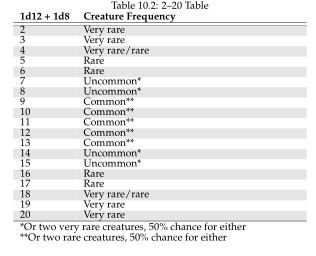
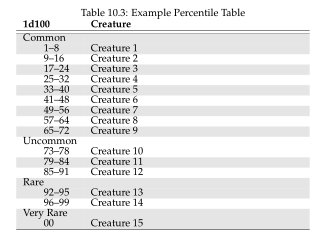
There's no deep wisdom offered on how to populate the tables. The rarity on the tables above is the rarity listed on the monster's stat block in the bestiary: Orcs are everywhere and thus are "common" encounters, for example, while owlbears are "rare". The GM should obviously adjust to taste, and remember to add some encounters that don't involve wandering monsters as well.
The book doesn't include much advice on which specific creatures to pick, but it does mention that the level of the monsters should be proportional to that of the dungeon. I mean, "dungeon level" as an abstract difficulty rating of the dungeon, not the physical floor of the dungeon. Levels. The creature's level is determined by its XP value, which is also listed on every creature's bestiary entry. For every level above or below the dungeon level, the creature becomes more rare: In a third-level dungeon, a common first-level creature would be rare, and you shouldn't include any seventh-level creatures even if their statblock says they're common. The monsters' bestiary entry includes the "number appearing" for a typical encounter, but the book admits that this might end up being overwhelmingly large and suggests erring on the side of smaller encounters when in doubt.
quote:
Although a dungeon’s level should correspond with the PC’s level, there’s never any guarantee that a dungeon will be safe or easily conquered.
There's a very short paragraph (that honestly should be a sidebar, but I guess that technology didn't exist in 1989) on good traps and tricks to place in a dungeon, and a reminder that the players should get XP for successfully disarming traps. (Note that the fighter face-tanking the rolling boulder does not count as "disarming".) Instant death effects, unavoidable traps, logic puzzles or riddles are specifically pointed out as frustrating for most people. Suggested stuff include magical bubbles that trap creatures but can be popped with piercing weapons, animated statues that talk of point towards further encounters, one-way doors, room-sized elevators and shifting passageways.
In the great outdoors, there's no "dungeon levels" so the PCs might run into anything from wandering merchants to hill giants. The book recommends giving lower-level PCs a chance to avoid really dangerous encounters.
quote:
If the PCs wish to risk their lives they can make that choice, but forcing them into an untenable fight is poor refereeing.

The GM should make different encounter tables for different wilderness regions, towns and even specific districts of larger cities to give each their own character. That's a shit-ton of tables, jeez.

The above table is a suggestion on how often the GM should make encounter checks based on the surrounding terrain and time of day. At the indicated times, the GM should roll 1d10 and if they roll equal to or below the number in the "check" column, a random encounter occurs. In a dungeon, the GM should make the check every hour (that is, every six turns) and whenever the PCs cause a ruckus.
For planned encounters, the GM should decide if any creatures are hostile or passive. Hostile creatures attack on sight while passive ones opt to talk first. Being passive doesn't mean being nice however: The book's example of a passive encounter is a group of bandits trying to shake the PCs down for some cash. In case the GM doesn't have a reaction planned, they're instructed to roll 2d10 plus any modifiers, and reference the table to find out how the encounter starts. Modifiers include the characters' charisma as well as any applicable modifiers from the morale section of the combat chapter.
Surprise!
When one or more parties have a chance of getting caught off-guard, a surprise check is in order. The GM rolls a d10 for each party; 3 or lower means they're surprised. There's a bunch of suggested modifiers.
If someone fails their surprise check, everyone not surprised gets a surprise round where they can perform all actions they normally could, except for spellcasting. Surprised characters lose their Dex bonus to AC. If a party purposefully sets up an ambush, they get an extra round of attacks before the surprise round.
Surprise affects the starting distance between parties. Regardless of environment, if both parties in an encounter fail their surprise rolls, they start a mere 3d6 feet away. Unsurprised parties begin the encounter tens of feet apart, depending on the terrain and darkness.
Coming up next: Chapter 11: Experience!
Chapter 11: Experience
Original SA post
For Gold & Glory: Chapter 11: Experience
This chapter is short and sweet, since it's only a page long.
quote:
Experience is added up and divided evenly among all surviving players at the end of a session or adventure. Dead characters or recently resurrected characters should receive experience for events that happened up to their death.
Unlike in previous editions, XP for encounters isn't determined by the value of loot found, but by the HD of enemies defeated. The creature stats in the bestiary include their XP value, but if you need to make up your own, there's a table. If the monster has special abilities or is particularly tough, you should treat its HD as higher and award more XP. AC 0 or lower is a +1 modifier to HD, magic resistance is a +2 and energy drain is a +3, for example.
Characters can also get XP for achieving "prominent story-related goals", whatever that means, and the characters can set goals for themselves as well. These rewards shouldn't exceed the total XP awarded for the encounters overcome on the way – the journey is the reward, or something.
The book appears to have no guidelines for making characters above 1st level whatsoever.
Coming up next: Chapter 12: Treasure, Magical Items, and Research!
Chapter 12: Treasure, Magical Items, and Research
Original SA post
For Gold & Glory: Chapter 12: Treasure, Magical Items, and Research
This isn't the chapter with the magical items, those are all in appendix C. This chapter is all about how to make those things instead.
quote:
Treasure is any item the characters acquire on their journey that has value

The chapter is titled "Treasure", but there isn't much said about non-magical treasure we didn't already cover when we looked at coinage. Creatures might have valuable stuff! Non-intelligent creatures probably don't, but maybe a shark's eaten something worth selling? Better gut it to make sure! (Ew.) The bestiary in appendix C lists treasure codes for creatures encountered, but the actual treasure lists are in appendix B.
Just like encounters, treasure can be both planned and randomised. Planned treasure should "reward or entice" players. Random encounters should carry some random amount of treasure with them, but the book repeatedly reminds us that intelligent monsters only carry useful stuff and leave their valuables in their lair. So if you roll any useless valuables, remember to put them down somewhere in the dungeon I guess?
Welcome to Honest Bobbe's Magick Shoppe!
quote:
There is little to no market in magical items

Magical items usually appear as mundane things, although divination magic can used to figure out what the hell you've found. Good thing all wizards begin knowing detect magic, otherwise figuring if you've found anything magical to begin with would be a huge pain in the ass.
Cursed items are designed to fool divination magic because whoever makes them is a complete dick. When the curse activates, the character can not get rid of the item until the curse is broken. It will keep reappearing in their
There's a lot of hype about magical items and they're totally rare you guys so nobody would bother dedicating an entire shop to them! They probably have a lot of sentimental value! And so, their monetary value is completely up to the GM, although XP value times 100 gp is suggested. (What's the XP value? Dunno, but we'll find out eventually.) Most people don't actually have hundreds of gold pieces in liquid cash, so exchanging magic items for stuff like plots of land, titles or simply other magic items is suggested.
Magic items typically require a full round to activate. Enchanted weapons, armour and such automatically grant their benefits and characters will realize what's happened. The book makes a big deal about figuring out all the functions and commands of a magic item, which sounds like a bit of a faff.
Too many magic items can't be worn together. You can only wear one ring per hand, one pair of bracers, a helmet or a hat but not both, and so on. Wearing too many will make them all turn off. You have to wear both pairs of a matched set of boots. The book isn't entirely clear if you can wear a magical cloak over a magical robe or not, but you could in Baldur's Gate so I'm gonna go with "yes".
A wizard did it
Spell casters can make magic items depending on their level. This isn't mentioned anywhere in the class descriptions. Wizards learn to brew potions at 7th level while clerics have to wait until 9th, and both can scribe scrolls at 7th level and from level 11 onwards they can create all other magic items. The player should describe what they want to make, and the GM should lead them on the appropriate adventures.
Magical scrolls are the easiest magical item to create. You only need a few days of peace and quiet, and about as much money as it would cost for a wizard to scribe that spell into their spell book. How much is that? Who knows! The character class descriptions don't say anything about learning new spells so it's probably in appendix A. To scribe a scroll, the caster needs to know the spell, and own the appropriate quill, ink and paper. The inks might require special sympathetic ingredients to create. It takes a full day per spell level to scribe the spell onto the scroll, and any "prolonged interruption" beyond eating, sleeping and potty ruins the scroll. When the process is finished, the GM should secretly roll a percentage die for success. The odds are okay (80%, minus the spell level, plus the character's level) but if the check fails, the scroll is cursed. Fun.
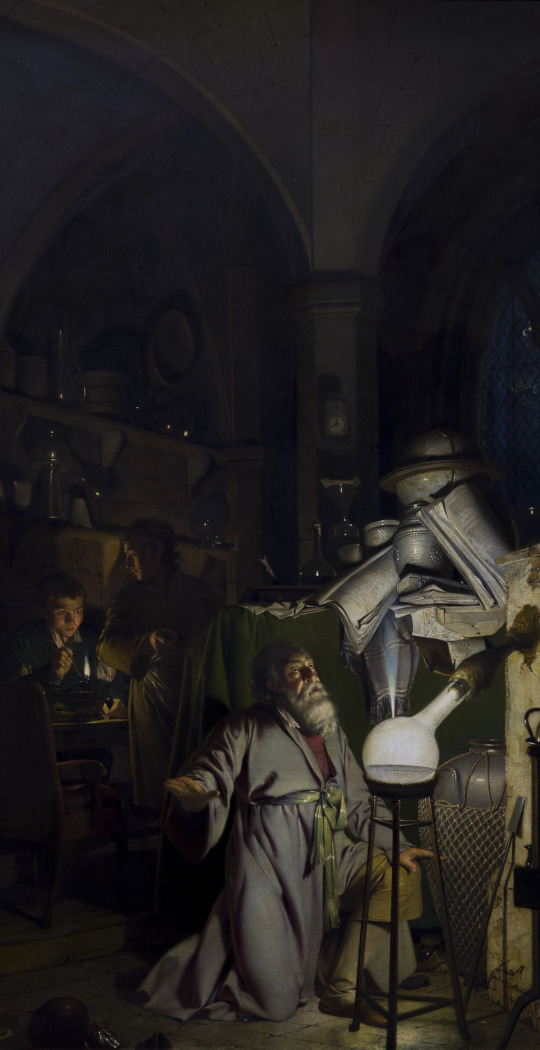
Joseph Wright of Derby: The Alchemist Discovering Phosphorus, detail. 1771.
According to the book, potions are about twice as expensive as scrolls but require less time to brew. Unlike scrolls, they require access to a magical laboratory or a powerful holy site. A potion is basically a spell in a bottle, so the caster must again know the spell they're using. Potions require mundane ingredients costing between 200–1000 gp, plus any arbitrary special ingredients. The brewing process takes a number of days equal to the cost in gp divided by 100, so 2–10… Which means the process takes roughly as long as scribing scrolls, unlike promised.
 The odds of successfully brewing a potion are lower than for scribing scrolls: 70%, minus 1% for every 100 gp spent on ingredients, +1% for every two character levels. There are no guidelines for determining the cost of the ingredients.
The odds of successfully brewing a potion are lower than for scribing scrolls: 70%, minus 1% for every 100 gp spent on ingredients, +1% for every two character levels. There are no guidelines for determining the cost of the ingredients.Incidentally, a wizard's lab requires at least 2000 gp's worth of equipment, plus 10% a month to replace worn-out equipment. Rent not included.

Crafting other magical items is more involved, particularly if you're a wizard. Whereas scrolls and potions might require stuff like ashes from the watch captain's torch or the tail of a chameleon, creating a properly magical item can be an entire adventure that spans weeks or even months of in-game time.
To begin with, the magical item requires a flawless, blinged out vessel created by a master craftsman, costing some thousands of gold pieces. This certainly helps with identifying magical items in a hoard of loot. In addition, magical components such as esoteric oils or gem dust are necessary to prepare the vessel to accept the magic, and these should cost at least 500 gp. Finally, a laboratory shielded from magical energies is required to prevent the item from becoming contaminated with unwanted magic.
Once the vessel is ready, the process begins with the spellcaster casting enchant an item on it. Then they have 24 hours to cast any magic they want to imbue into the item. A wand of fireballs is a simple matter of stuffing it full of fireball spells, but weirder items might require esoteric components or straight up researching a new spell. For each spell cast into it, the item rolls a save vs. spell as if it was the caster because… Making things would be too easy otherwise?
If the magical effects are meant to be permanent instead of having charges, a permanency spell is required. There's a 5% chance of permanently losing a point of constitution when finalizing the creation of a magical item.
After that, a final percentage check is rolled to see if everything went well or if the item turns out cursed. It's harder than the ones for scrolls or potions because… Fuck you for trying to get your hands on a custom magical item I guess? It's weird. After that, there's some more rolls to see if the magical item is actually a super-powered "archetype" item. (Unlikely)
Priests, on the other hand, have an easier time!
 Instead of expensive ingredients, and custom spells they only need a consecrated (as well as blinged-out and exceptional) vessel and three weeks of ritual followed by days of prayer. Every day of prayer has a cumulative 1% chance of enchanting the item. When the enchantment finally happens, if the item is meant to hold charges, the spells should be cast onto the item within the next 24 hours. If not, I guess the god just slaps some permanent magic in there? The item is then sanctified and purified, and the process is done. It's suggested the GM should scrutinize the character's actions and decide if they've been sufficiently pious and whether their motivations are acceptable to their god. If not, the process goes to hell and the priest is left with a cursed item instead.
Instead of expensive ingredients, and custom spells they only need a consecrated (as well as blinged-out and exceptional) vessel and three weeks of ritual followed by days of prayer. Every day of prayer has a cumulative 1% chance of enchanting the item. When the enchantment finally happens, if the item is meant to hold charges, the spells should be cast onto the item within the next 24 hours. If not, I guess the god just slaps some permanent magic in there? The item is then sanctified and purified, and the process is done. It's suggested the GM should scrutinize the character's actions and decide if they've been sufficiently pious and whether their motivations are acceptable to their god. If not, the process goes to hell and the priest is left with a cursed item instead. 
Coming up next: Hirelings and Henchmen!
Chapter 13: Hirelings and Henchmen
Original SA post
For Gold & Glory: Chapter 13: Hirelings and Henchmen
"Hirelings & Henchmen" sounds like the title for some infinitely lamer retroclone.
Not everyone has the talent and gumption to become a mighty adventurer, which honestly makes sense considering the monsters waiting for us in appendix B. Instead, the vast majority of people live quiet lives practicing a trade or whatever, and as a result develop skills that adventurers might find very handy.
Mechanically, these average people are 0-level characters. Their ability scores range between 3–18 like usual, but they don't get any racial modifiers to them, presumably for the sake of simplicity. Note, however, that any racial modifiers to combat stuff still apply, so ogres are going to have a hard time hitting dwarven NPCs. The hit points of 0-level characters vary by profession: Soldiers start with a respectable 1d8+1, a craftsman a 1d6 and a scholar a measly 1d3. Their THACO is always 20 and all their saves suck. They start skilled in one appropriate weapon and one appropriate trade skill.
quote:
Hirelings generally refuse to go on adventures, but they’ll accompany PCs and wait at safe locations, such as a camp outside a dungeon.
Assassins murder people. Not monsters, just people. It's more of a mindset than an occupation.
 They charge completely arbitrary amounts of money and hiring one is never either good or lawful. What are the odds of a successful hit? It's all up to the GM! If it'd be more interesting that they fail, get captured and spill the beans, maybe do that. Or don't. I'm not the city watch.
They charge completely arbitrary amounts of money and hiring one is never either good or lawful. What are the odds of a successful hit? It's all up to the GM! If it'd be more interesting that they fail, get captured and spill the beans, maybe do that. Or don't. I'm not the city watch.Spies are like assassins but they don't kill people.

Sages are experts in their fields who can be hired to explain stuff to the PCs. They like to hang out in cities since that's where the university libraries are. There's a table for determining the chance to find a sage of a particular field. Lots of sociologists and linguists around, but very few architects, it looks like. The sage should know as much as necessary to keep the adventure progressing, but in case it's not critical info, you could also leave it to a die roll. There's a proficiency roll (exactly like a skill roll) that gets harder the more specific questions the PCs ask. The sage needs some time (up to a month, for a very specific question) to do their research, and the PCs are expected to pay the library fees.
Soldiers are 0-level characters who, unlike the other hirelings, have no qualms about participating in adventures. They provide their own kit, but expect to be fed and lodged. There's a bunch of different sorts the players can hire, from simple footmen and shield bearers to artillerists and siege engineers.
The book helpfully reminds the GM that the players can only hire hirelings if there's a ready labour supply, and most professionals already have a job. Also, word might get around it the party gets employees killed on the reg. I guess that's so the GM can ixnay the players' entirely original idea of filling the entire Tomb of Horrors with the bodies of the locals.
There's a table for weekly wages, but the players are expected to foot the bill for expenses like food and lodging.That must be why the equipment chapter had all those tables for provisions and lodging.
In addition to hiring people, players can also pay a spellcaster to cast a spell. There's a big list of prices, with the caveat that priests are picky about the spells they cast. There's no suggested cost for a raise dead spell, for instance, even though a footnote suggests that even PCs of the correct alignment might owe the temple a payment or a service. How much money is your buddy's life worth?
 It's suggested that the same list could be used if the party wizard wants to copy a particular spell to their spell book. (Looking at the prices, spell piracy is probably absolutely rampant in mage academies.
It's suggested that the same list could be used if the party wizard wants to copy a particular spell to their spell book. (Looking at the prices, spell piracy is probably absolutely rampant in mage academies.  )
)If common hirelings don't provide enough muscle, the situation calls for henchmen. Henchmen are NPCs with actual levels in a class, hired or otherwise persuaded to join the PCs in their adventures. Unlike hirelings, henchmen gain experience from adventuring (albeit only half) and expect a cut of any treasure. It's not said outright, but the book implies that every henchman follows a specific player character. The number of henchmen a character can have is determined by their charisma score. If, through roleplaying, the PC and their henchman become "close friends or allies", the GM should hand the henchman's character sheet over to the player and let them control both characters.
Coming up next: Appendix A: Magic Overview and Spells
The next update might take a day or two, since I need to go through the entire spell list
Appendix A, part I: Magic Overview
Original SA postTook me a bit to get back to the book.  The appendices are all quite long compared to the earlier chapters, so I'm going to split them up into multiple updates. For magic I'm going to begin with the overview, and showcase a handful of spells in the next update. Let's get back to business!
The appendices are all quite long compared to the earlier chapters, so I'm going to split them up into multiple updates. For magic I'm going to begin with the overview, and showcase a handful of spells in the next update. Let's get back to business!

For Gold & Glory: Appendix A, part I: Magic Overview
So, there's two kinds of magic: Wizard magic and priest magic. Wizard magic leans on "energy inherent to the universe" while priest magic usually comes from some kind of deity or their representative. But the book hastens to add that faiths with no deities can also grant magic to their faithful, in case you want to go the whole "no gods no masters" route.
Spell it out for me
The big thing that separates the two kinds of magic is that wizards need to learn their spells one by one, as well as keep a physical record of them. Spells are big things and learning them is taxing, which means a wizard can only learn so many spells. The specific limits are in the ability score section, because they're governed entirely by the character's intelligence. Here's the relevant table again:

Remember how I rolled a 16 for that example character I made a while ago? That's an all-round good score, but a wizard with Int 16 just flat-out couldn't learn 9th level spells until they find some kind of stat booster. They could learn 11 spells per spell level, which is reasonable, but still a slight limiter on Unlimited Batman Power. In an actual game these would both be late-game concerns, but there's something that would kick their ass throughout their career: That 70% chance to learn new spells. That means that about a quarter of all spells found will just refuse to stick, and a wizard can't retry learning a spell until they've gained an entire level. Which is a bit annoying because wizards are the slowest to advance in level. So, uh, maybe consider just flat out shoveling scrolls at the party wizard if you decide to run the game?
The game seems a bit confused on how a wizard goes about learning new spells. The class description for the mage and the specialist mage says that they learn one free spell for every new spell level they get. Appendix A says wizards learn a new spell every "experience" level. Ask your GM, I guess! In any case, these spells are learned automatically and for free. In addition, the wizard can attempt to learn new spells by copying them from a scroll or a spell book to their own spell book. This is yet another money sink, since the process requires expensive material components that cost 50 gp per page. Like I mentioned in the last chapter, wizards are likely to charge you for the privilege of copying their spells. Regardless of its length, copying a spell takes an entire day of effort to make sure you get it just right, and the spell scroll you're copying from is destroyed in the process. (Spell books are unaffected.) And there's that failure chance I mentioned, presumably rolled after the scroll is consumed.
Every new spell requires a number of pages equal to the spell level plus 1d6-1. So a 1st-level spell averages 3.5 pages long, a 2nd-level spell 4.5, and so forth. Every 1st-level wizard starts out with a 100-page spell book. If they learn about 10 spells per level, they need to get a new spell book when they hit level 5 and get access to 3rd-level spells. New spell books aren't expensive as far as adventuring gear goes and they come in various sizes, but the logistics of traveling with your magical library might get a bit hairy. Paper has terrible saving throws, so remember to make backups!
Finally, before a wizard can cast a spell, they must memorize it. They need an uninterrupted full night's sleep before beginning the memorization process, which takes 10 minutes of study per spell level memorized. So, uh, hope you weren't in a rush because Fizzbang here needs to memorize some 6th-levels. Memorized spells don't go away until they're cast, and memorizing spells always requires a full rest to recharge your batteries, so you can't change your repertoire on the fly.
Priests don't have to worry about learning spells, since they get access to all their faith's magic through prayer. Priest spells are organized into "spheres" and priests gain minor or major access to them based on their chosen faith: Minor access means they can only memorize spells up to 3rd level, while major access goes all the way up to 7th. Priests memorize spells like wizards: After a good night's sleep, they must spend 10 minutes in prayer for each spell level memorized. The GM is encouraged to dick the priest over if they don't act according to their faith's tenets. (The text says "tenants", but I don't think clerics are meant to play divine janitor to people living on church land.)
If a spell doesn't exist, an enterprising spellcaster can attempt to invent one. The process begins with a player writing up the description for the new spell, casting time and all. The GM then looks at it and compares it to existing spells. If the spell's just "this cleric spell, but for wizards" it should go up a spell level, and upgrades for existing spells should go up two. When the GM and the player agree on the spell's level and effects, research begins. It takes at least 2 weeks per spell level and costs 100–1000 gp per level, but the GM might hike either number up at their pleasure. Research also requires a laboratory or place of worship, presumably like the ones described in the treasure chapter. Remarkably, the character can pause and resume their research at will to go on adventures. At the end of the research process, a check is made to see if the research bears any fruit: Wizards roll their learn spell chance while priests roll a regular wisdom check. (Incidentally, the spell learning chance is such that priests will have the better odds until the wizard reaches Int 19.) A successful roll means the spell is learned, while a failure means the time and money went to waste.
Colours of magic
Magic is categorised into nine different schools:
- Abjuration protects against magical energies and banishes magical creatures.
- Conjuration manipulates matter to create or summon objects and creatures.
- Enchantment changes the qualities of matter and even the thoughts of creatures.
- Divination grants the caster knowledge. It's divided into common "lesser divination" and the more specialised "greater divination" which can even peer into the future.
- Illusion deceives minds and senses.
- Evocation channels and shapes energies like, uh, fire and sound.
- Necromancy is the manipulation of life force and negative energy.
- Transmutation transforms things from one form to another and alters things like space and time

Incidentally, when we get to the spell list, even priest spells list which of these schools they belong in because there is some amount of overlap. Unlike wizard spells, priest spells also organised into 16 spheres: All, Animal, Astral, Charm, Combat, Creation, Divination, Elemental, Guardian, Healing, Necromantic, Plant, Protection, Summoning, Sun, and Weather. This list of spheres is hidden all the way back in the class chapter. Like I mentioned earlier, priests only gain access to some of these spheres, based on their faith. The baseline cleric gets a wide range of access, but I guess the implication is the GM should adjust it for their campaign setting.
Because their effects are explicitly not real, the school of illusions get a bunch of extra rules. Illusions are sensory figments with no physical substance, while phantasms exist only in the subject's mind. The subject's expectations and senses should affect any saving throws made against illusions: An frozen lake in the middle of a desert isn't entirely credible and the PCs should maybe get a bonus, for example. A successful saving throw usually makes a character immune to an illusion's effects, and they can grant their allies a +4 bonus on their next saving throw by warning them about the illusion. Willfully disbelieving an illusion takes a full round, but it's not quite clear what that means. I guess you get to roll a saving throw? The book specifically advises against letting NPCs roll to disbelieve, unless they have a very good reason to do so.
Since this is a violent game, illusions might fool characters into believing they've taken damage. The GM needs to track illusionary damage separately, since it goes away the moment the character successfully disbelieves the illusion. If a creature would die of illusionary damage, they go comatose and must roll a system shock roll. A failed roll means they die of shock, while a successful roll means they wake up 1d3 turns (so 10–30 minutes) later and realize it was all an illusion. If the illusionary situation (a falling wall, say) would kill them outright, they roll the system shock roll and if successful, get an immediate saving throw at a +4 bonus. A successful saving throw means they immediately disbelieve the illusion, while failure means they faint for 1d3 turns. It's very cute and clever, but illusionary damage sounds like a pain to track.
Coming up next: Appendix A, part II: Spells!
Appendix A, part II: Spells
Original SA post
For Gold & Glory #17: Appendix A, part II: Spells
Uhhhh hi guys it's been a second.
 I'm gonna try to finish this thing now!
I'm gonna try to finish this thing now!Last time I started tackling the sizable appendices with an overview of how magic works. This time we'll take a look at some spells.
This game has a lot of spells. The tables listing all the spells by level take five pages, and the descriptions a whopping 107. Some of the spells are quite short and fit six to a page. Others, such as Reincarnation are massive, involve multiple tables and take up two whole pages. There is no table of contents for this section, so make sure to write down the page number in case Thief steps in a fire trap again and needs to get dragged back to life.
Making magic
Spells have a bunch of moving parts. Let's take a look at an adventuring staple and I'll highlight some bits:
quote:
Cure Light Wounds (Necromancy)
Caster/Level (Sphere): Priest/1 (Healing)
Range: Touch
Duration: Permanent
Effective Area: 1 creature
Components: V and S
Casting Time: 5
Saving Throw: None
This spell allows the caster to restore 1d8 HP of damage to the creature touched. The healing cannot affect creatures without a corporeal body, the undead, non-living, or extra-planar creatures. Only current wounds are healed, and the spell does not prevent future wounds.
The reverse, cause light wounds, requires a successful touch attack to inflict 1d8 HP of damage to the victim. Treat wounds caused by the reverse as any normal injury.
Certain spells are reversible, and this is indicated by the italicized spell name. This means you only need to learn one spell to use either of its applications. However, you need to decide which version of the spell you want when you memorize the spell, you can't flip on the fly. Besides necromancy spells that can be used to either heal or harm, other spells allow you to adjust the ambient lighting, transmute flesh to stone and back again, or shrink and enlarge creatures (
 ). This is actually a really neat touch because hoo boy learning spells is hard enough already.
). This is actually a really neat touch because hoo boy learning spells is hard enough already. The Caster/Level line does not mean "caster level". It's character class and spell level, okay? Priests get first level spells on first level, second level on third level, third level on fifth level, and so on. And when the spell's effect says it deals, say, 1d6 damage per caster level, it means your levels in the relevant spellcasting class. It's 1989, okay?
Cure/Cause Light Wounds affects one creature you can touch. Remember that a spellcaster can't move at all when casting a spell, lose their dexterity bonus to AC, are delayed in initiative (more on that in just a bit) and lose the spell if they get damaged or fail a saving throw before their turn comes up. As far as I can tell, there is no way to "hold" a touch spell ready either (unless the description says otherwise), so you only get that one round to poke your target to death, assuming they haven't wandered off out of your reach. Touch spells seem… Bad. Other spells might have an area of effect, which might be a "15-foot hemisphere" or a "20-foot cube". There are no guidelines for applying these shapes onto a map, so good luck with that.
As an aside I'm pretty sure the duration of this spell is incorrect. According to the rules, a "permanent" spell lasts until dispelled, even though other damage-dealing spells are usually "instantaneous" instead. As a cool detail, a caster can verbally dispel their own spell prematurely without having to resort to a Dispel Magic.
Spell components! Ah yes, everyone loves spell components. Cure Light Wounds only has somatic and verbal components, meaning the caster must have both hands free and be able to speak clearly. A spell might also have more or less flavourful material components, such as the bat poop and sulphur required for a Fireball. According to the rules, destroying a spell component before the spell finishes casting is one more way to interrupt a spell, but there are no further rules for them. Do you have to keep track of them? Who knows!

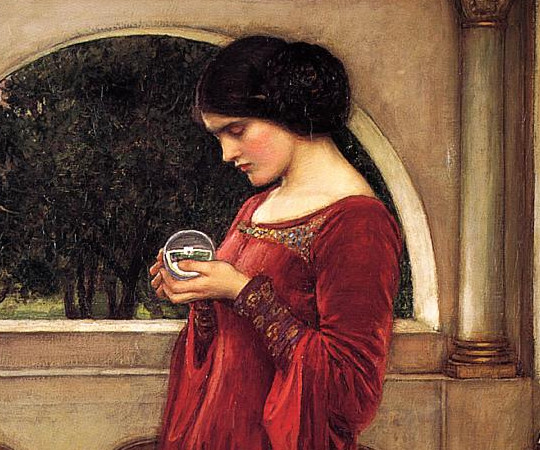
John William Waterhouse: The Crystal Ball, detail. 1902.
The casting time of a spell is expressed with either a simple number (as here) or a concrete unit of in-game time (such as "1 round"). When it's a simple number, it represents an initiative penalty: As you might remember, in this game actions are declared at the beginning of every round, after which initiative is rolled. Spellcasting begins when actions are declared and concludes when the caster's initiative count rolls around, and throughout all that, the caster is vulnerable to attacks because they can't move. If the casting time is a round or more, the spell finishes at the end of that period, after everyone else has taken their actions.
The spell also lists the effect of a successful saving throw, if one can be made. The spell might be negated altogether, or the effect might be halved. The spell's description might be explicit about the specific saving throw that needs to be made, but sometimes you'll just have to pick the most appropriate one by ear. It's possible to voluntarily fail a saving throw, and the book helpfully reminds us that if a PC fails a saving throw against a fireball, all their equipment also need to save against it.
Finally, there's the spell's actual description which spells out any remaining hoops the caster must jump to use it, and all its weird corner cases. For example, a Fireball bursts out of an enclosed space if its AoE is too big, and a Lightning Bolt bounces off walls like a billiard ball for whatever reason. It's very cute and cool, but I also hate it because these are exactly the kind of details that bogs a good round of combat right down. "Ooh but if I nudge the Fireball that way wouldn't the column of fire hit the Goblin Shaman and maybe set the Cursed Scroll of Macguffin on fire lemme grab my calculator–"

Don't hurt me!
A lot of the magic in this book is entirely devoted for solving encounters with force, either by doing unto others, or by preventing them from doing unto you. But there are also other, weirder spells. Check these out:
quote:
Pass Plant (Transmutation)
Caster/Level (Sphere): Priest/5 (Plant)
Range: Touch
Duration: Special
Effective Area: Special
Components: V, S and M
Casting Time: 8
Saving Throw: None
This spell allows the caster to enter one living tree and (if desired) exit from another, with a maximum distance determined by the type of tree involved. This spell will require some additional terrain details to be provided by the GM, as both trees must be of the same type, and they both must be large enough for the caster to physically fit inside of them. [. . .]
 I'm absolutely positive this one exists entirely because Gygax wanted a druid who could make like a tree.
I'm absolutely positive this one exists entirely because Gygax wanted a druid who could make like a tree. 
quote:
Quest (Enchantment)
Caster/Level (Sphere): Priest/5 (All)
Range: 60 yards
Duration: Until fulfilled
Effective Area: 1 creature
Components: V, S and M
Casting Time: 8
Saving Throw: Negate
This spell attempts to force a creature to perform a quest of some kind as determined by the caster and return with proof of the completed deed. [. . .]
All in all, the spells themselves really underline the weird position spell casters were in AD&D. On the one hand, they can be really powerful, with spells that poop out a bunch of damage or really debilitating status effects. On the other hand, spellcasting in combat is an absolute pain in the backside and practically demands the rest of the party to play pretty tight defense for their artillery battery. Even a thrown rock can be enough to interrupt the fight-deciding spell.
There's also a ridiculous range in the various spells' scope. Some, such as Cure Minor Wounds there, have a clear adventuring application, and you can use it to make basic magical items. Spells like Quest (or the wizard spell Magic Jar, used to turn into a lich) on the other hand, are clearly just mechanical scaffolding for traditional D&D plots.
And then there's the incredibly niche shit like Pass Plant and Protection from Cantrips (
 ) that reminds me of this stuff more than anything else:
) that reminds me of this stuff more than anything else:
Coming up next: Appendix B, part I: Mundane treasure!
Appendix B, part I: Mundane Treasure
Original SA post
For Gold & Glory #18: Appendix B, part I: Mundane Treasure
This first part's short since it's only about money and things you can easily exchange for money.
Cash rules everywhere around me
The core of this whole appendix are a pair of somewhat arcane-looking tables:


The first table runs A–I, the second J–Z, so there are a bunch of rows in these. All monsters in the bestiary have in their statblock a "Treasure" line that may contain some of these letters. For every letter, the GM should roll all the dice on the row to figure out what kind of treasure the monster is either carrying or has stashed in its lair. A percentage chance is often included to indicate the likelihood of encountering any treasure of that particular type.
For example! Halflings own treasure of both B and K types. Therefore, when our brave heroes bust the gate to the Halfing Warrens, kill the gang of 2d6 ferocious little monsters patrolling the corridors and rifle through their pockets, they'll find 3d6 silver pieces from row K. Once our heroes find the halflings' storeroom and sleeping quarters, they might find all kinds of stuff from row B, such as 1d4 random commodities, 1d8 gemstones or even a magical weapon of some kind! However, all of row B's entries come with percentage chances, so our heroes are unlikely to find something from every column, and might miss out on treasure altogether.
After that's done, the GM then has to figure out what specific kind of commodities, gemstones or magic items the players find. First he picks some arbitrary commodities from the equipment chapter or the tables in the appendix, then rolls on the gem value table to figure out the base value of the found stones, then on the gem value variation table if the gems are cut (who decides if the gems are cut? The GM, obviously), and then rolls on more tables to figure out what kind of weapon it is and how is it enchanted. And then probably decides it's a halfling-sized weapon, so good luck with that, heroes.
In case you're wondering why there are separate columns for different kinds of coins, remember that 50 coins of any kind weigh one pound.
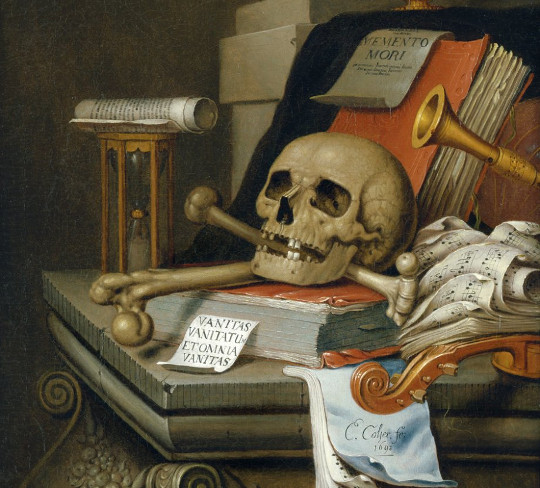
Edwaert Colyer: Vanitas Still Life, detail. 1693.
Get the money
There are so many tables in this appendix, and I'm simultaneously already done with it and left wanting more.
Done with it, because this is an absolute dog of a chapter to say anything about and honestly not laid out very clearly. The table for objects of art is placed two paragraphs after the actual text that refers to it, and the table for those in-between paragraphs is over on the next page. Some tables are meant to be rolled on, some are just for reference, others are just add-ons to the completely useless ones I complained about back when I did the chapter on equipment.
Yet I'm also left wanting more, because I genuinely like it when a game gives a GM tools like this. What's in the dungeon? Well uh
 halflings, uhm,
halflings, uhm,  23 of them, they've got, umm
23 of them, they've got, umm  three camels, a painting of a naked dude, and a magical pair of shoes. This part of the appendix would be a lot better if it went the distance and had proper random tables for absolutely everything you might find so that the GM wouldn't have to think too much. If I ran D&D regularly oh man I would do nothing but wacky random crap like that.
three camels, a painting of a naked dude, and a magical pair of shoes. This part of the appendix would be a lot better if it went the distance and had proper random tables for absolutely everything you might find so that the GM wouldn't have to think too much. If I ran D&D regularly oh man I would do nothing but wacky random crap like that.Incidentally there are no guidelines for anything in this part, beyond encouraging the GM to roll for treasure in advance so that they can place it sensibly and prepare some descriptions. There's no consideration for questions such as "how much money is too little/not enough" or "how do you actually turn fancy clothes into money".
Coming up next: Appendix B, part II: Magical items!